Last Updated on January 18, 2024
The first time I heard about the ruins of the Ciudad Perdida (the Lost City), an ancient city hidden deep in the jungles of northern Colombia that is only accessible on foot on a strenuous four-day hike through the mountains, was in 2010, during my first visit to Latin America.
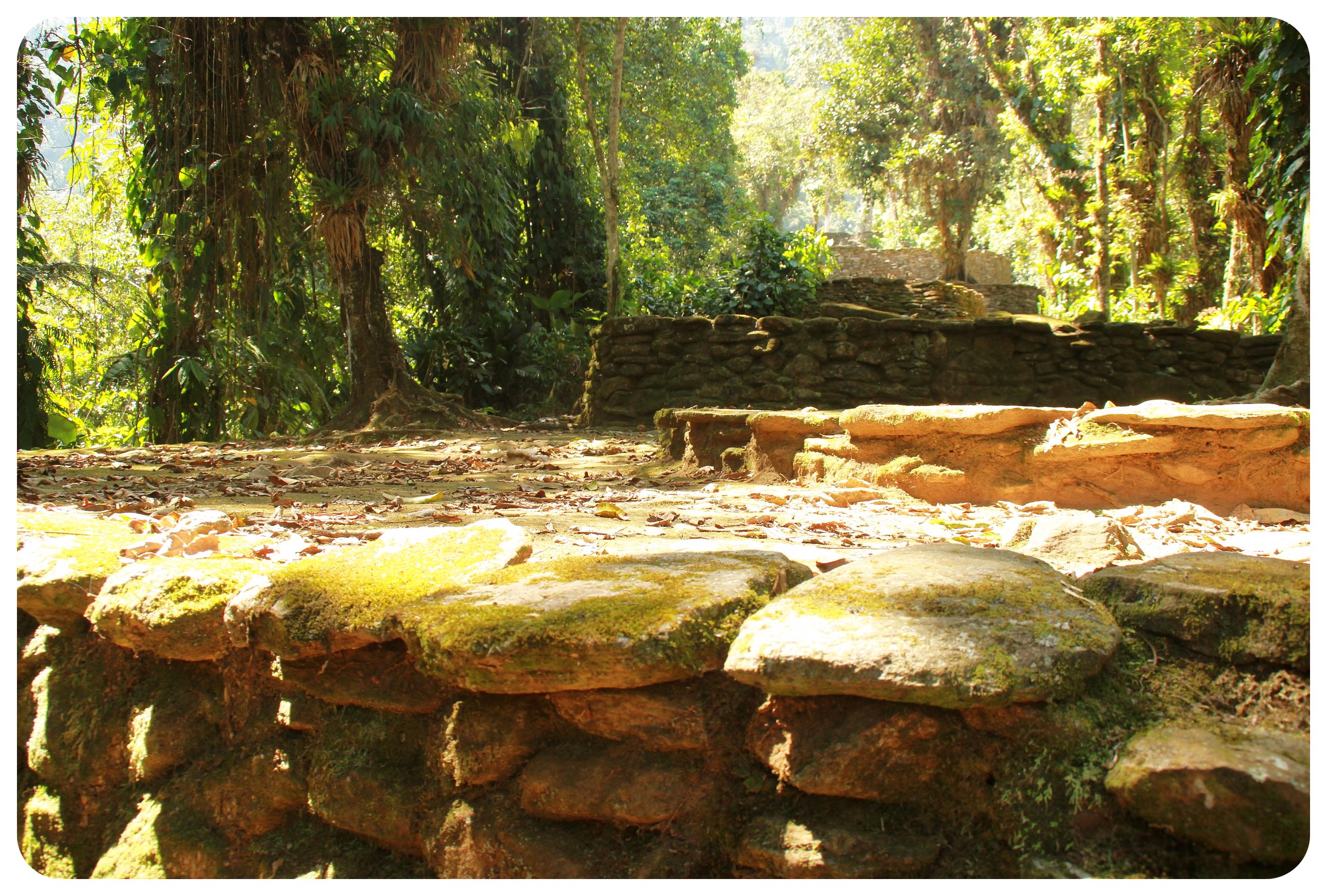
“You have to do the Lost City trek”
“You have to do the Lost City trek,” a fellow traveler who was making his way north towards Mexico as I was making my way down towards Colombia through Central America, urged me, “it’s an adventure of a lifetime.” Back then I was skeptical, even though I was intrigued by this Indiana Jones-like adventure. But I had never done a multi-day trek, let alone in the jungle, let alone in the Colombian jungle. I didn’t even know if I could walk that far: a 32-mile (52-kilometer) round-trip.
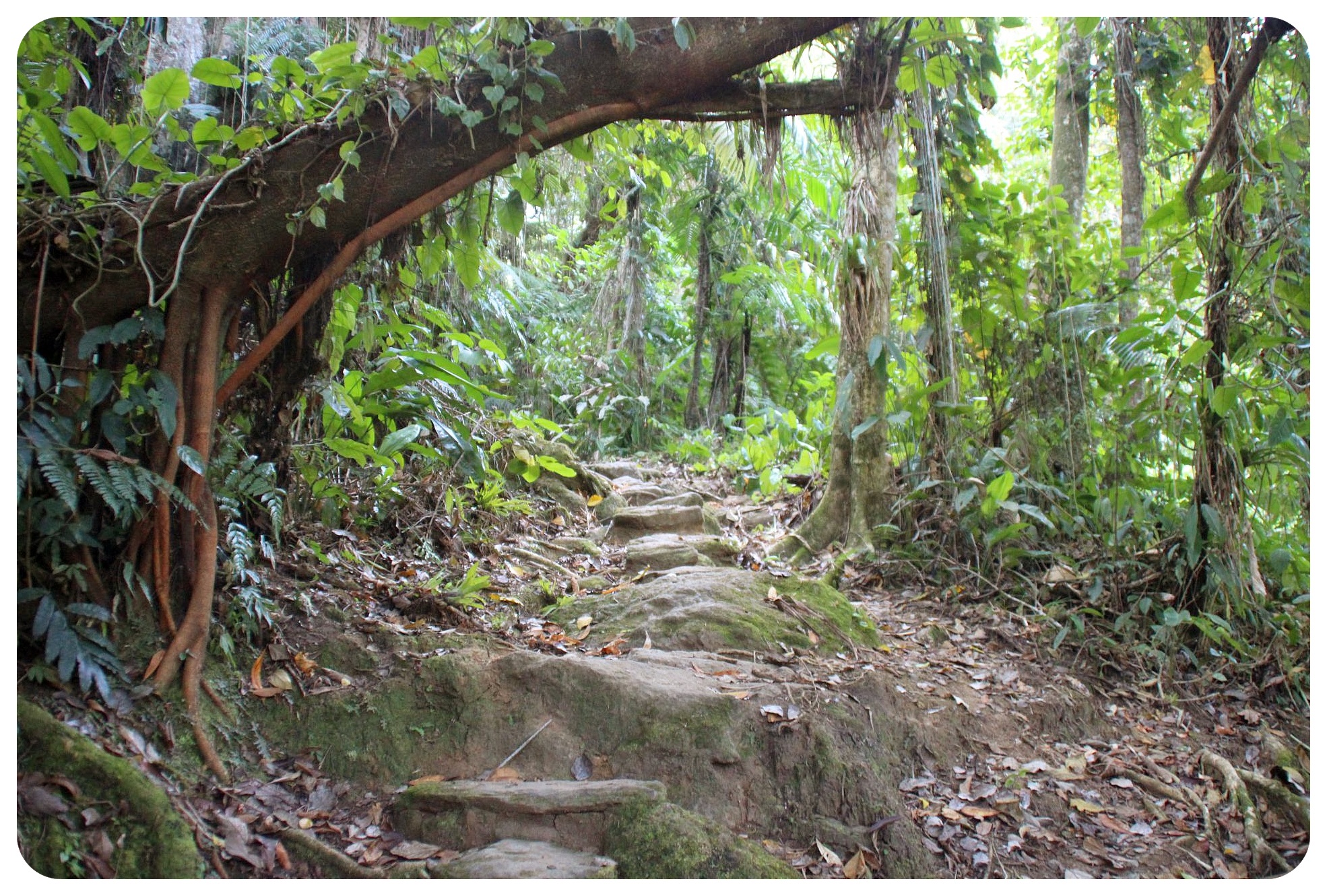 Fast forward six years and I found myself walking on a dusty unpaved road, braving the 90% humidity and heat of the Caribbean coast a few miles north of the starting point of the trek to the Lost City, La Ciudad Perdida.
Fast forward six years and I found myself walking on a dusty unpaved road, braving the 90% humidity and heat of the Caribbean coast a few miles north of the starting point of the trek to the Lost City, La Ciudad Perdida.
A mere fifteen minutes after leaving the village where we started the trek, we made our first river crossing – the first of about twenty river crossings along the way. Luckily I wasn’t doing the Lost City trek during rainy season, when the water can reach up to your waist. One hour into the hike, as I felt the sweat running down my arms, my stomach and my back, I was already regretting my decision.
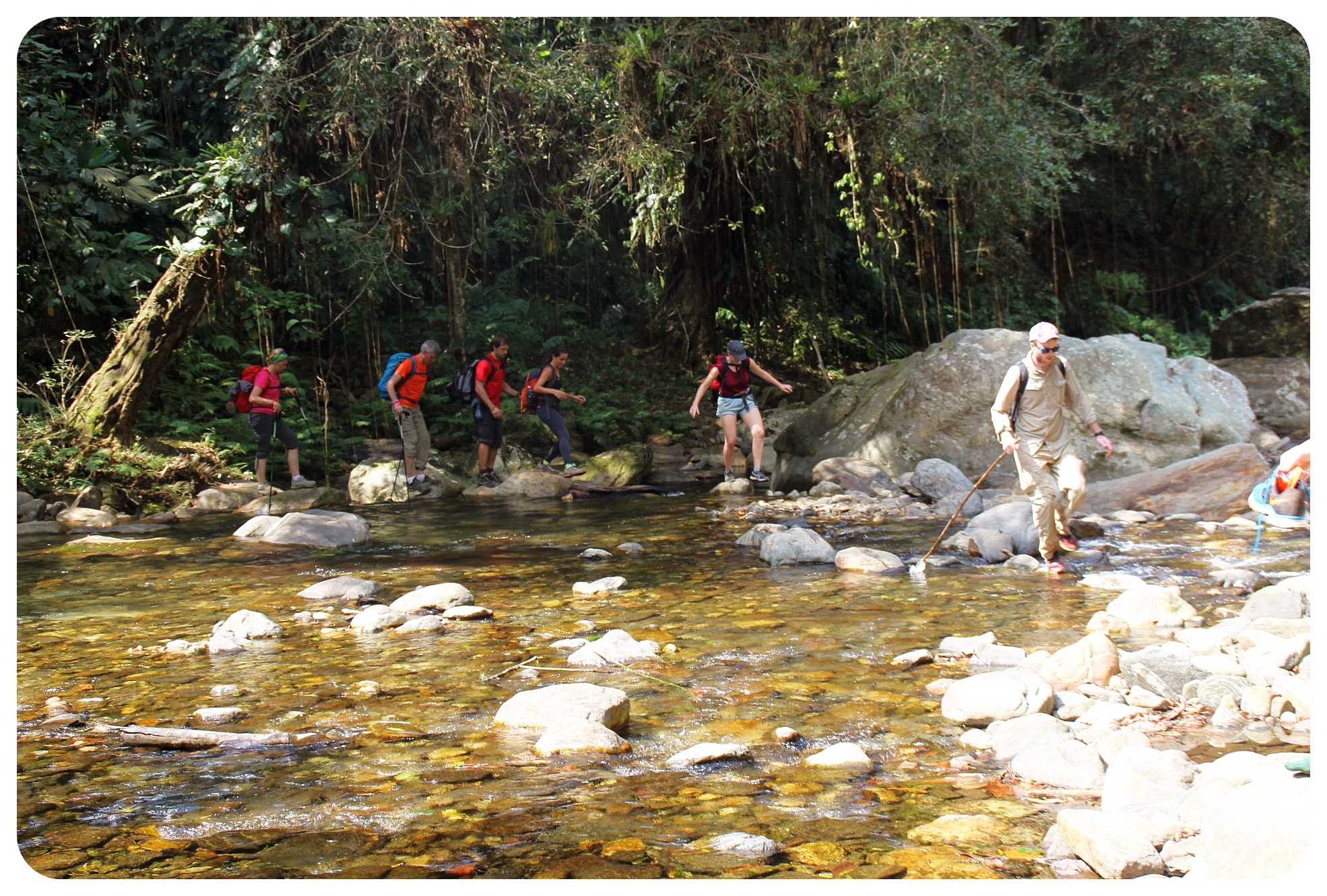 Even though now, a few years after first hearing about the hike to the Lost City, I had a few multi-day treks under my belt, I still wasn’t sure if I was going to be able to make it all the way to the ancient ruins high up in the mountains.
Even though now, a few years after first hearing about the hike to the Lost City, I had a few multi-day treks under my belt, I still wasn’t sure if I was going to be able to make it all the way to the ancient ruins high up in the mountains.
The river we were walking next to looked inviting, and just as I was fantasizing about jumping in for a refreshing dip, our guide announced “We’re stopping here for a quick swim break. After this, the real hike starts.” All of us stripped down immediately and jumped into the water, slowly starting to get to know each other while cooling off.
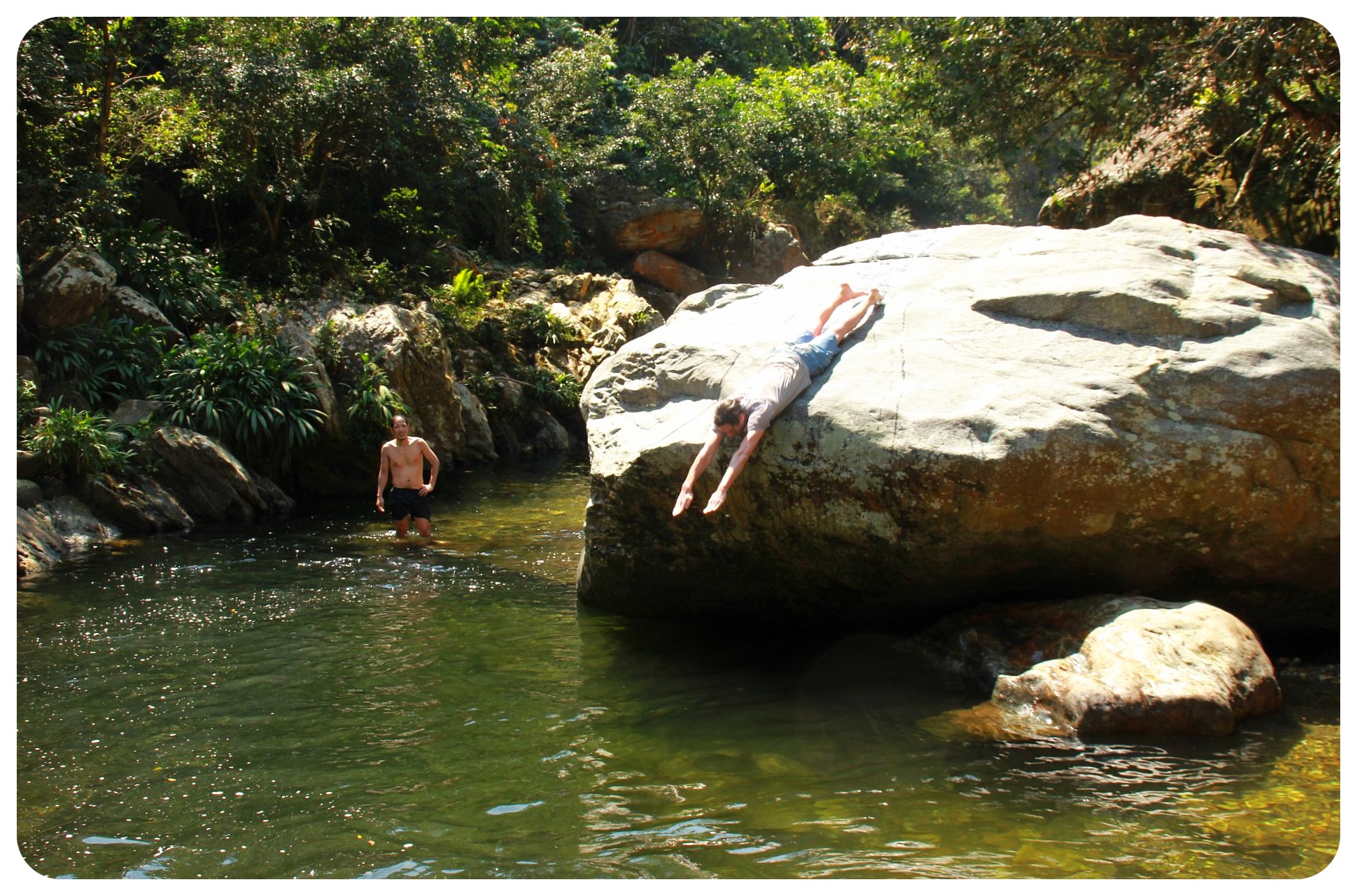 There were twelve of us, three couples, two friends traveling together, and the rest of us were solo travelers. Our guide hadn’t lied: The Lost City hike did become much more strenuous. Before our swim break, we had been slowly ascending into the mountains on a path surrounded by lush, green jungle. Now, it was pretty much uphill the entire time, and I was completely drenched in sweat within an hour. It seemed like this mountain didn’t have a top; a never ending ascent.
There were twelve of us, three couples, two friends traveling together, and the rest of us were solo travelers. Our guide hadn’t lied: The Lost City hike did become much more strenuous. Before our swim break, we had been slowly ascending into the mountains on a path surrounded by lush, green jungle. Now, it was pretty much uphill the entire time, and I was completely drenched in sweat within an hour. It seemed like this mountain didn’t have a top; a never ending ascent.
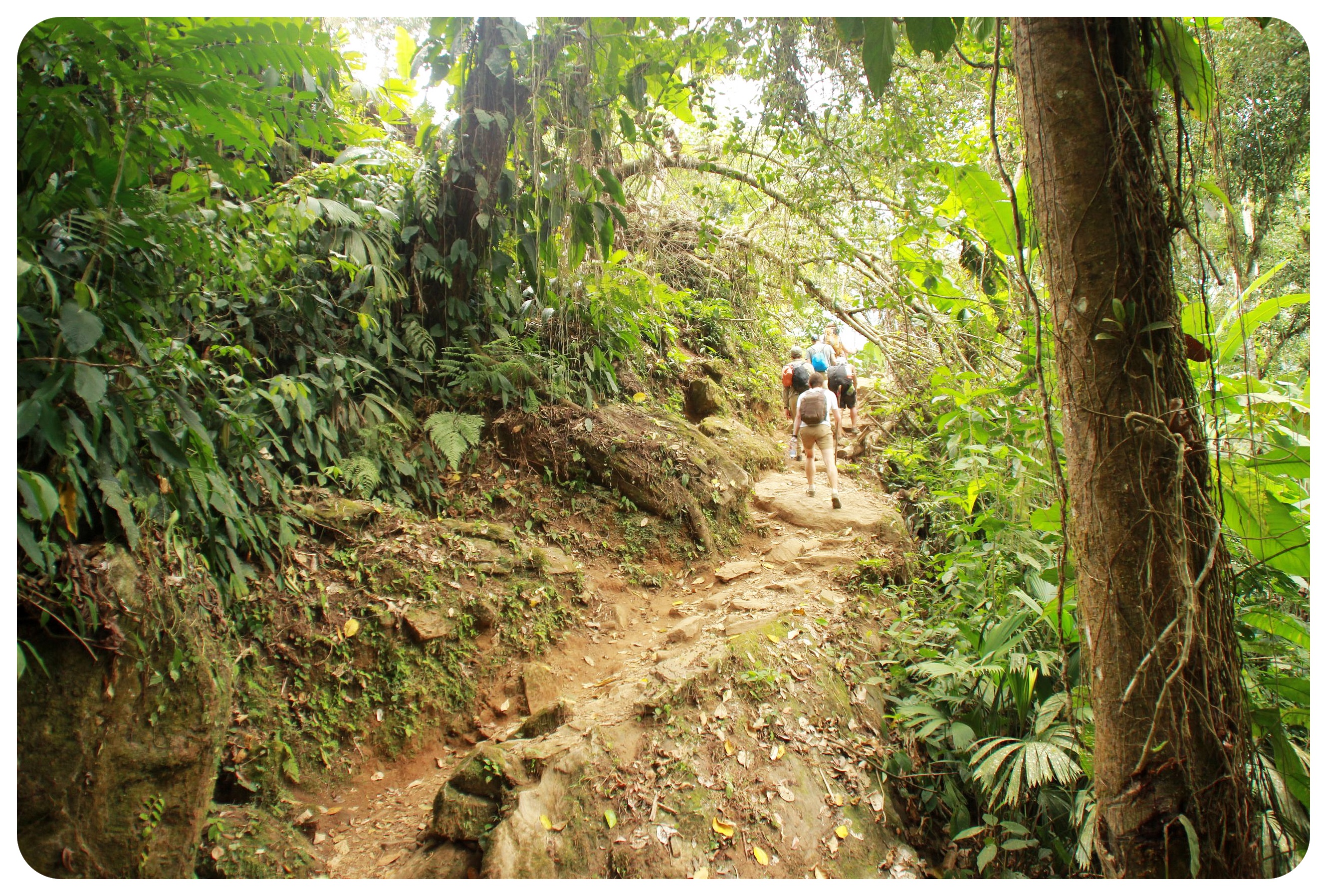 Luckily, the scenery distracted me enough to make this hike still enjoyable, and around 4.30pm, several mountains later, we reached the camp where we would spend the night, conveniently located right by the Buritaca River, which follows the trail pretty much the entire time. We didn’t waste any time and went straight down to the river where we found a refreshing pool and a cliff to jump from.
Luckily, the scenery distracted me enough to make this hike still enjoyable, and around 4.30pm, several mountains later, we reached the camp where we would spend the night, conveniently located right by the Buritaca River, which follows the trail pretty much the entire time. We didn’t waste any time and went straight down to the river where we found a refreshing pool and a cliff to jump from.
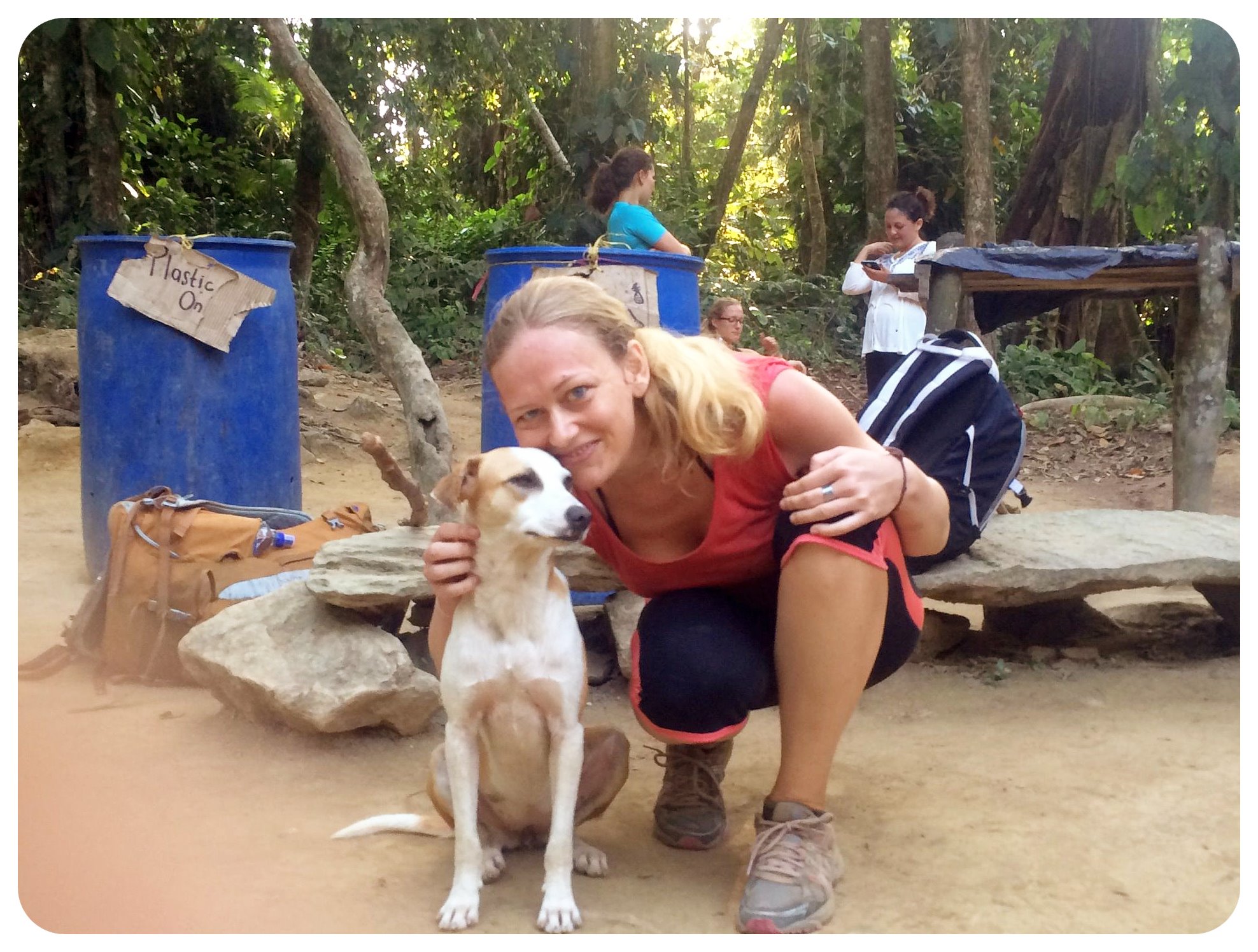 The accommodation was basic, a dozen bunk beds next to each other, right across from a TV in front of which the people who lived here sat, captivated by the telenovelas that were showing – they didn’t leave their chairs all night long. We sat down on wooden benches where we would be spending the rest of the evening, having dinner (fish and rice for the meat eaters, lentils and rice for me) and playing cards, getting to know each other better.
The accommodation was basic, a dozen bunk beds next to each other, right across from a TV in front of which the people who lived here sat, captivated by the telenovelas that were showing – they didn’t leave their chairs all night long. We sat down on wooden benches where we would be spending the rest of the evening, having dinner (fish and rice for the meat eaters, lentils and rice for me) and playing cards, getting to know each other better.
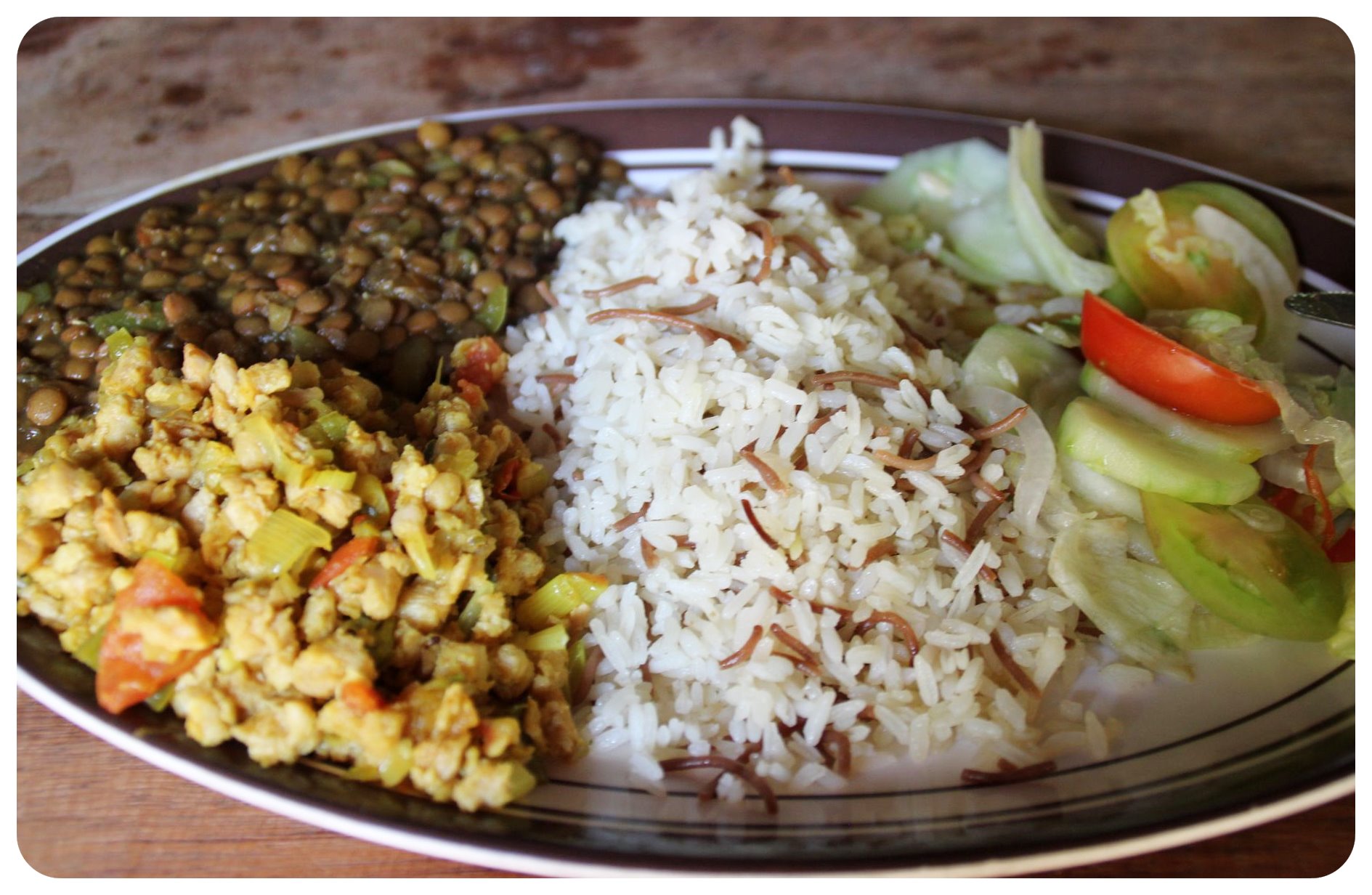 All of the camps on the hike to the Lost City were open, with corrugated roof sheets, but no walls. Luckily the beds were draped in mosquito nets to keep out the critters of the jungle – we had been warned that there were several species of poisonous snakes and spiders in this part of the country, and the very next day, I would nearly step on a snake.
All of the camps on the hike to the Lost City were open, with corrugated roof sheets, but no walls. Luckily the beds were draped in mosquito nets to keep out the critters of the jungle – we had been warned that there were several species of poisonous snakes and spiders in this part of the country, and the very next day, I would nearly step on a snake.
This would be the last camp that had electricity, after this point, electricity was provided by generators. During the entire trek there were no phones, no power outlets, no cell phone signal.
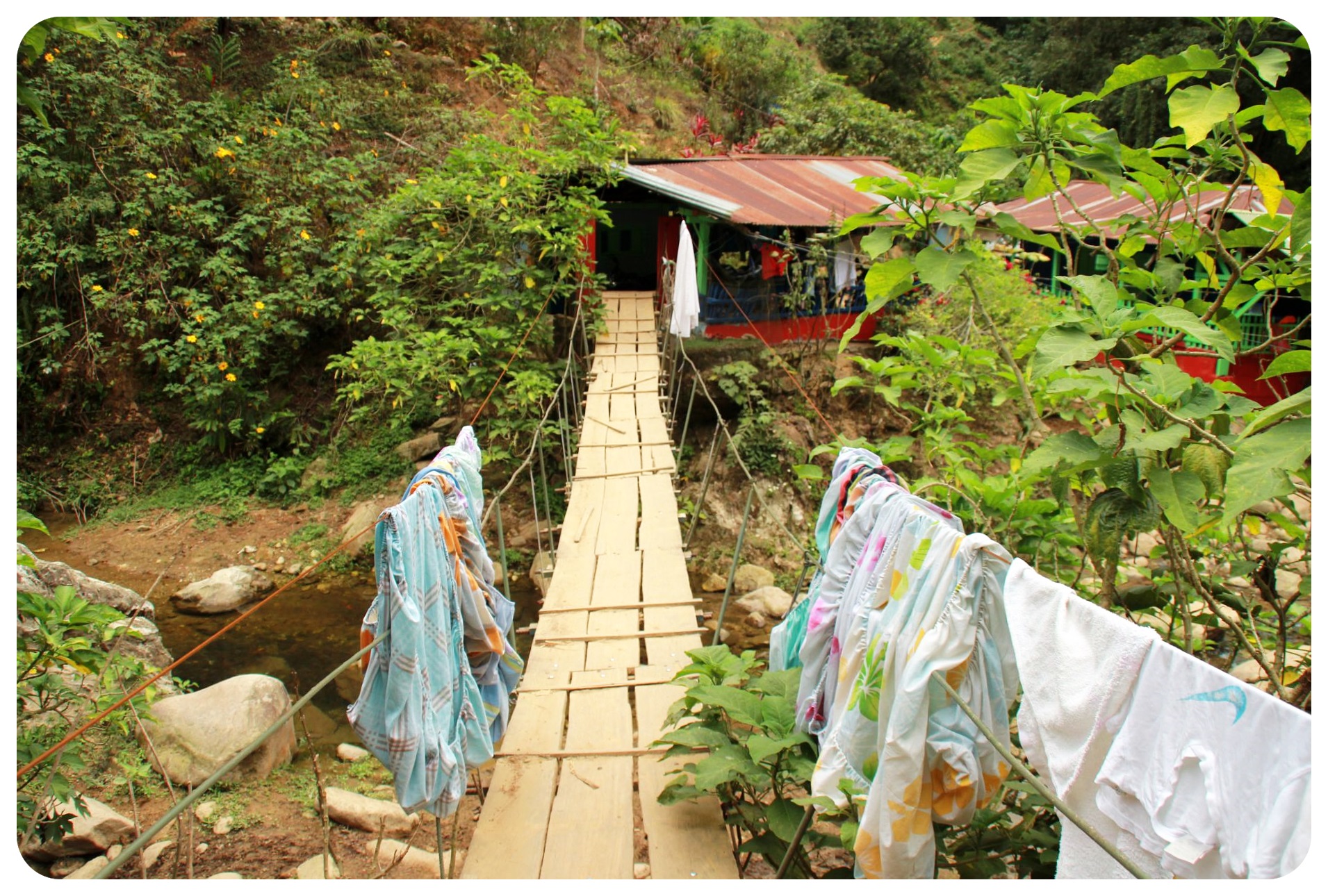 The next day, we were woken early: at 5am. After a filling breakfast that consisted of a big bowl of fresh fruit, yogurt and granola, we started walking an hour later, and just like the previous day we hiked up a mountain, down a mountain, up a mountain, down a mountain.
The next day, we were woken early: at 5am. After a filling breakfast that consisted of a big bowl of fresh fruit, yogurt and granola, we started walking an hour later, and just like the previous day we hiked up a mountain, down a mountain, up a mountain, down a mountain.
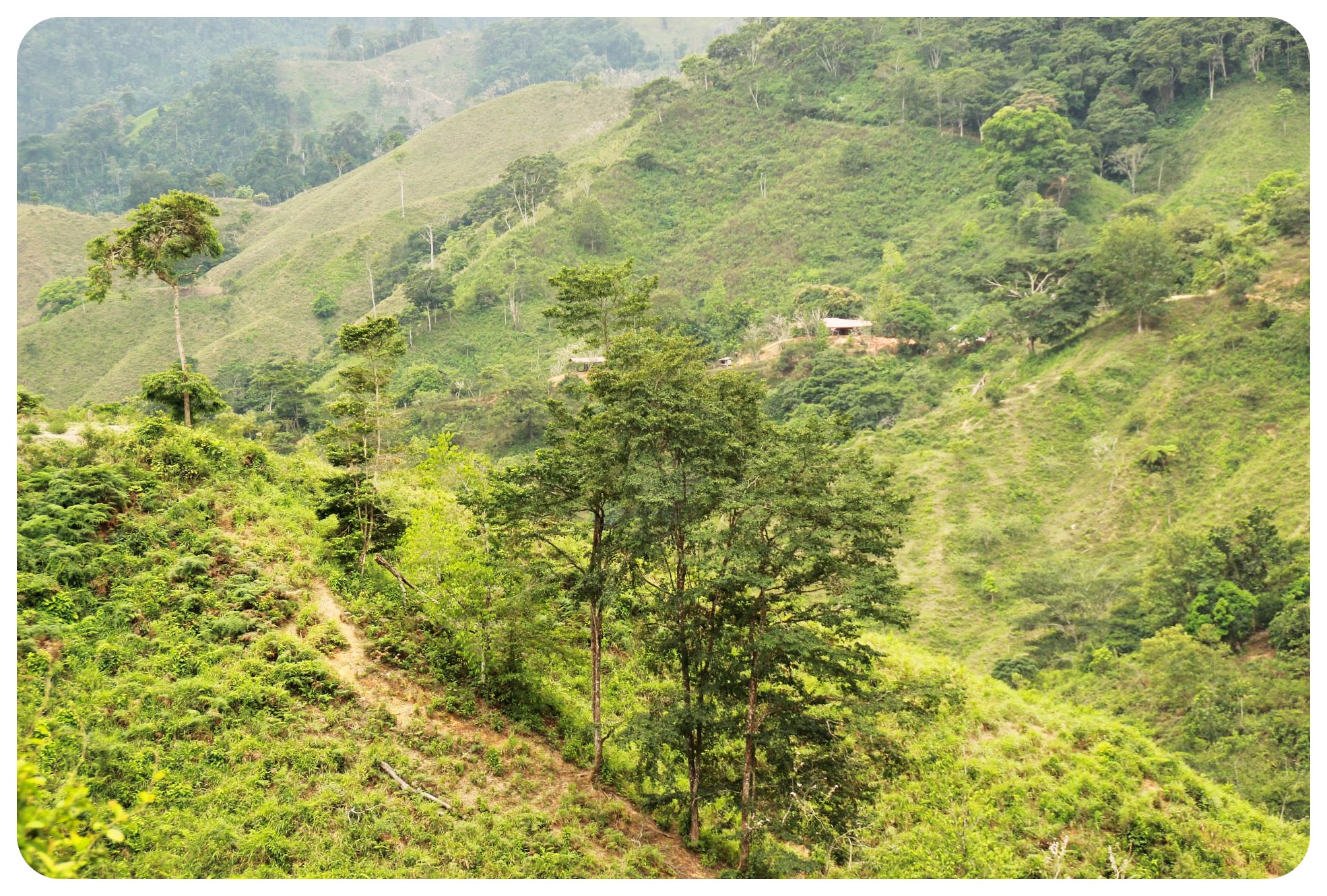 The jungle scenery was incredibly beautiful, and we passed several villages that were home to the indigenous groups who live in this part of the Sierra Nevada Mountains. There are the Wiwa people, the kankuamo, the arhuaco and the kogi, all descendants of the Tayronas, whose ancient city we were going to reach a couple of days later.
The jungle scenery was incredibly beautiful, and we passed several villages that were home to the indigenous groups who live in this part of the Sierra Nevada Mountains. There are the Wiwa people, the kankuamo, the arhuaco and the kogi, all descendants of the Tayronas, whose ancient city we were going to reach a couple of days later.
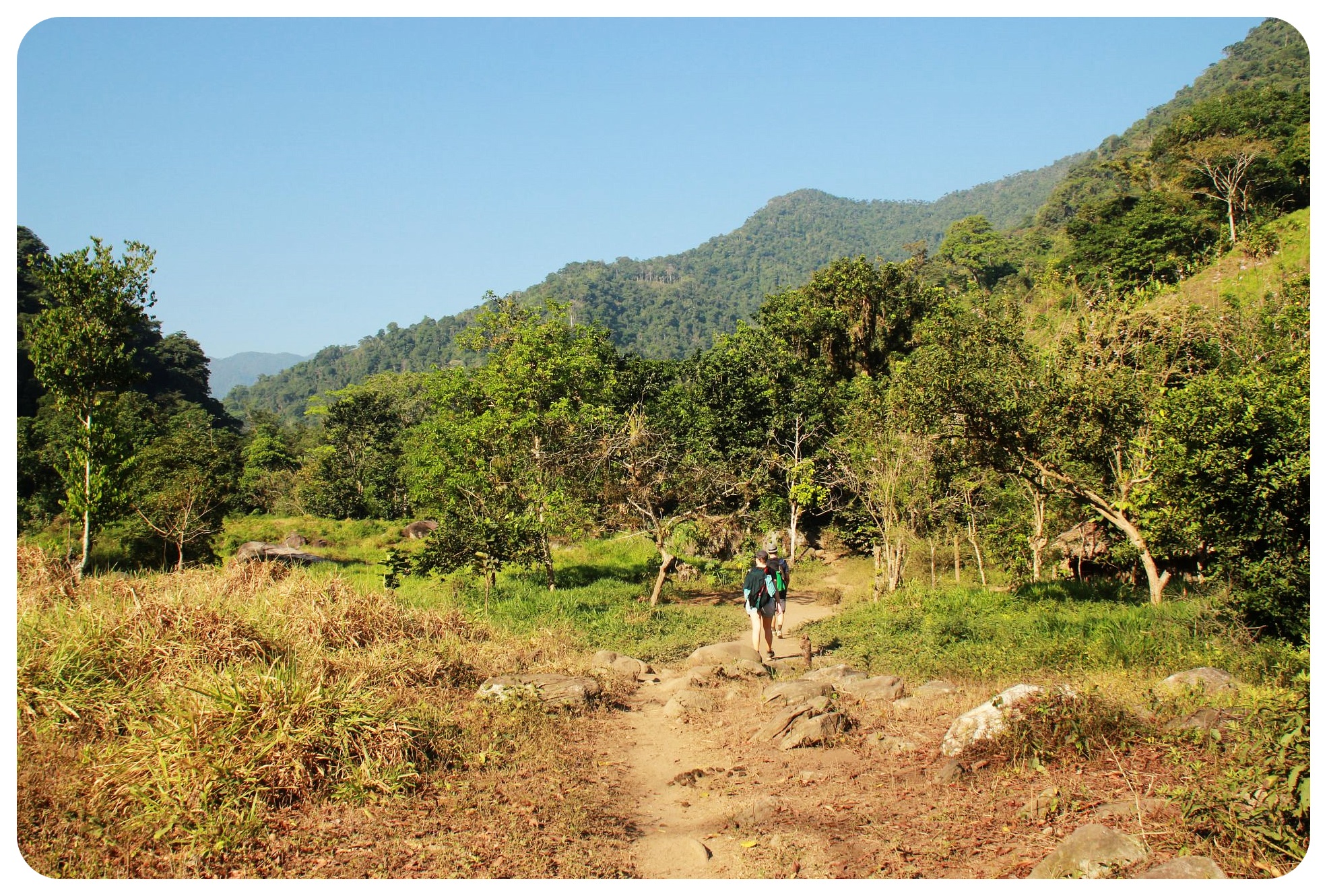 We didn’t see a lot of indigenous people on the first day, but now that we had gotten deeper into the mountains, we passed them frequently on the paths – moms with their kids, whole families, or just guys, easily recognizable by their traditional white outfits.
We didn’t see a lot of indigenous people on the first day, but now that we had gotten deeper into the mountains, we passed them frequently on the paths – moms with their kids, whole families, or just guys, easily recognizable by their traditional white outfits.
While the women and kids often were barefoot, the men wore big rubber boots and had long dark hair, always with a colorful handmade mochilla bag strung over their shoulder, similar to the ones I’d seen in the artisan markets along the coast.
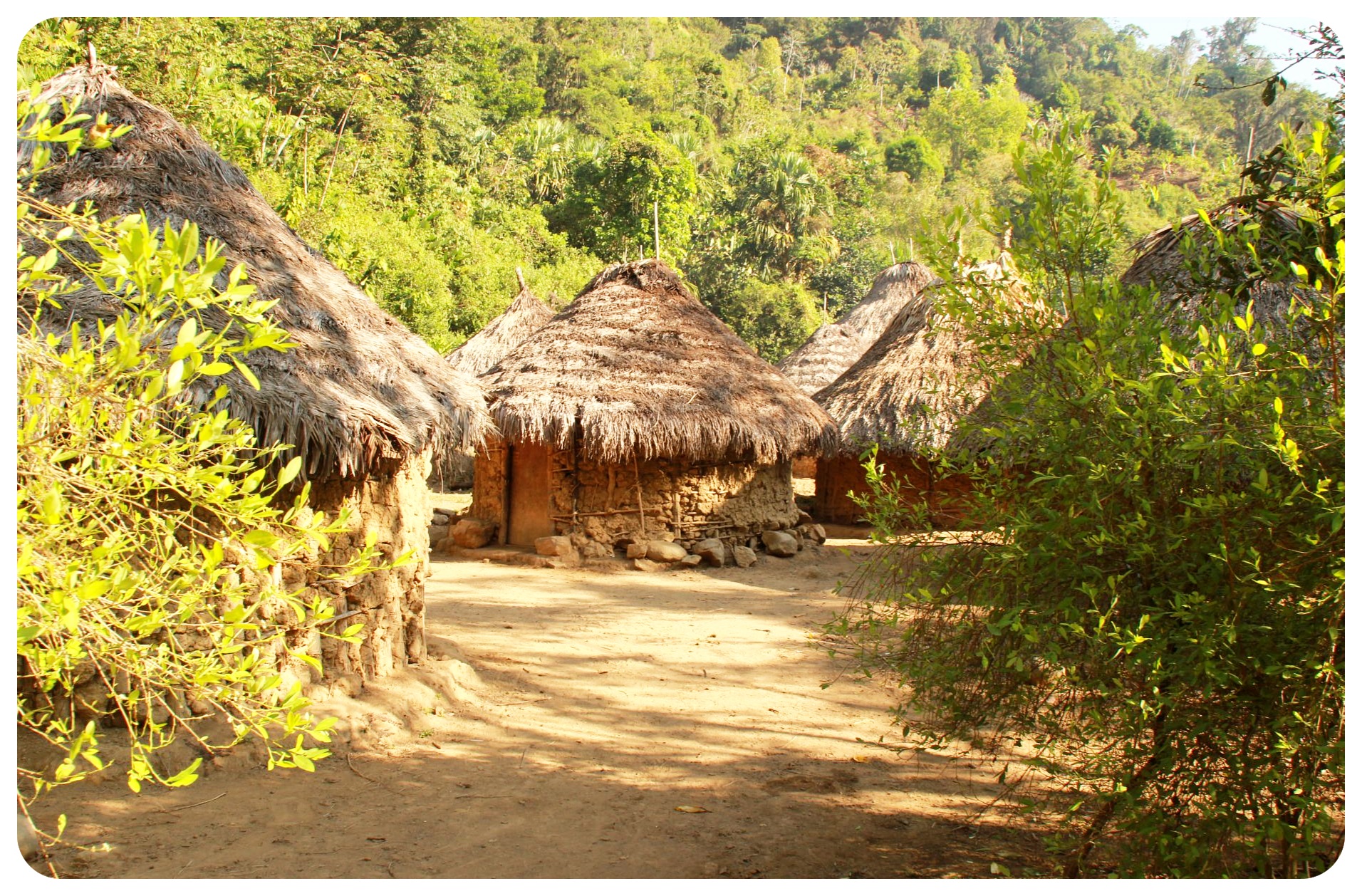 The huts in their villages are still built the way the Teyuna people used to build them: in a circle, and from materials found in the jungle. The kids here don’t get to just go to the candy store and buy some candy for themselves, but civilization hasn’t kept out of the jungle entirely: they know of candy, and know that white people tend to have candy on them.
The huts in their villages are still built the way the Teyuna people used to build them: in a circle, and from materials found in the jungle. The kids here don’t get to just go to the candy store and buy some candy for themselves, but civilization hasn’t kept out of the jungle entirely: they know of candy, and know that white people tend to have candy on them.
I ended up trading a couple of candies for a photo of a young girl and her babysitter before they disappeared into the jungle with a smile on their faces and I continued my trek through the forest.
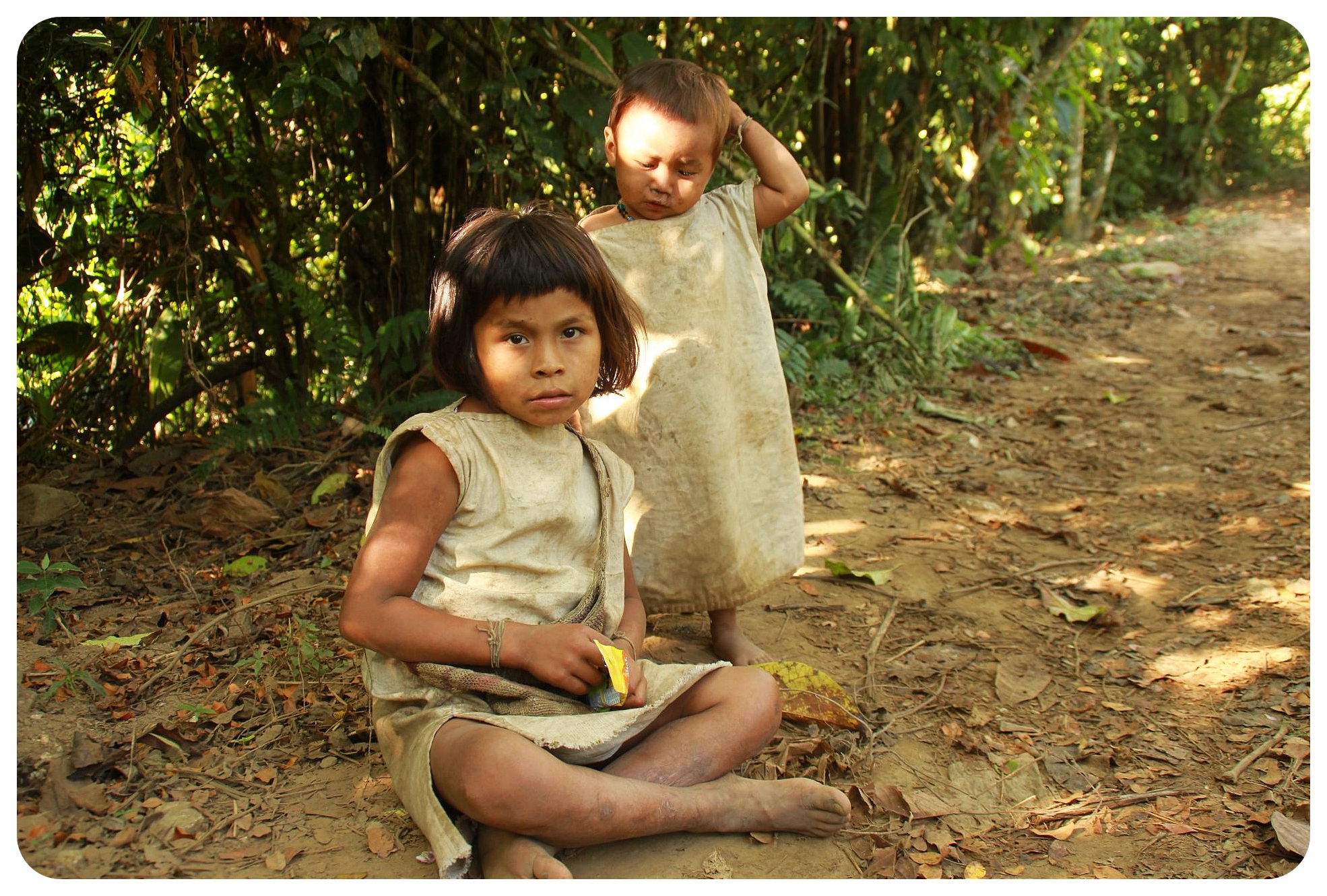 At 9am we reached our lunch camp, and while the two young girls who were cooking for us (and walking the trek with us) were preparing our lunch (which came pretty early at 10am), we swam in the river again. This would be the first of three (!) swim breaks that day.
At 9am we reached our lunch camp, and while the two young girls who were cooking for us (and walking the trek with us) were preparing our lunch (which came pretty early at 10am), we swam in the river again. This would be the first of three (!) swim breaks that day.
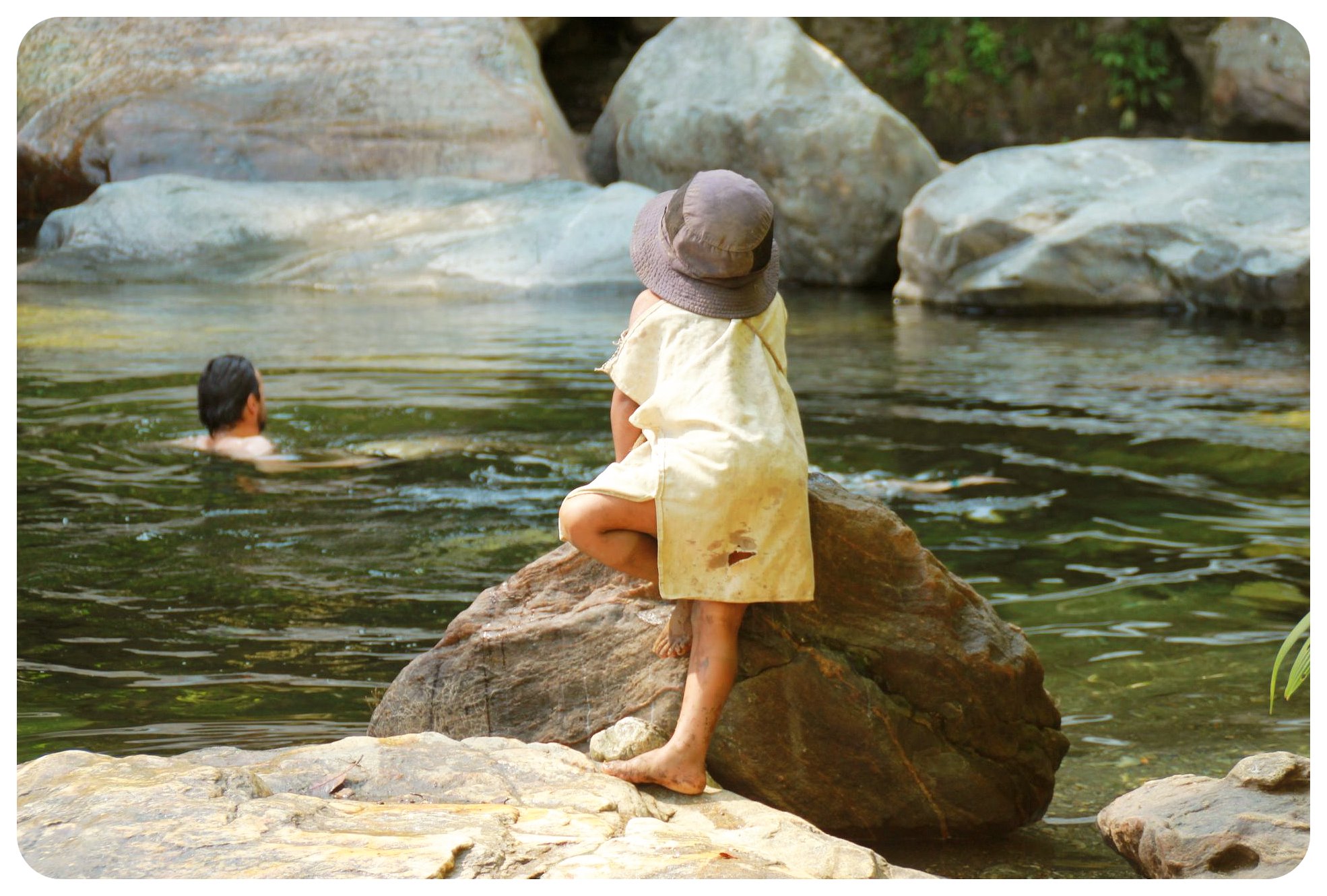 Once we finished our extended three hour lunch break, we started walking again – but only for half an hour. Then it was time for another swim, again surrounded by the lush jungle scenery. We almost didn’t care about our destination anymore, because the trek itself was so beautiful.
Once we finished our extended three hour lunch break, we started walking again – but only for half an hour. Then it was time for another swim, again surrounded by the lush jungle scenery. We almost didn’t care about our destination anymore, because the trek itself was so beautiful.
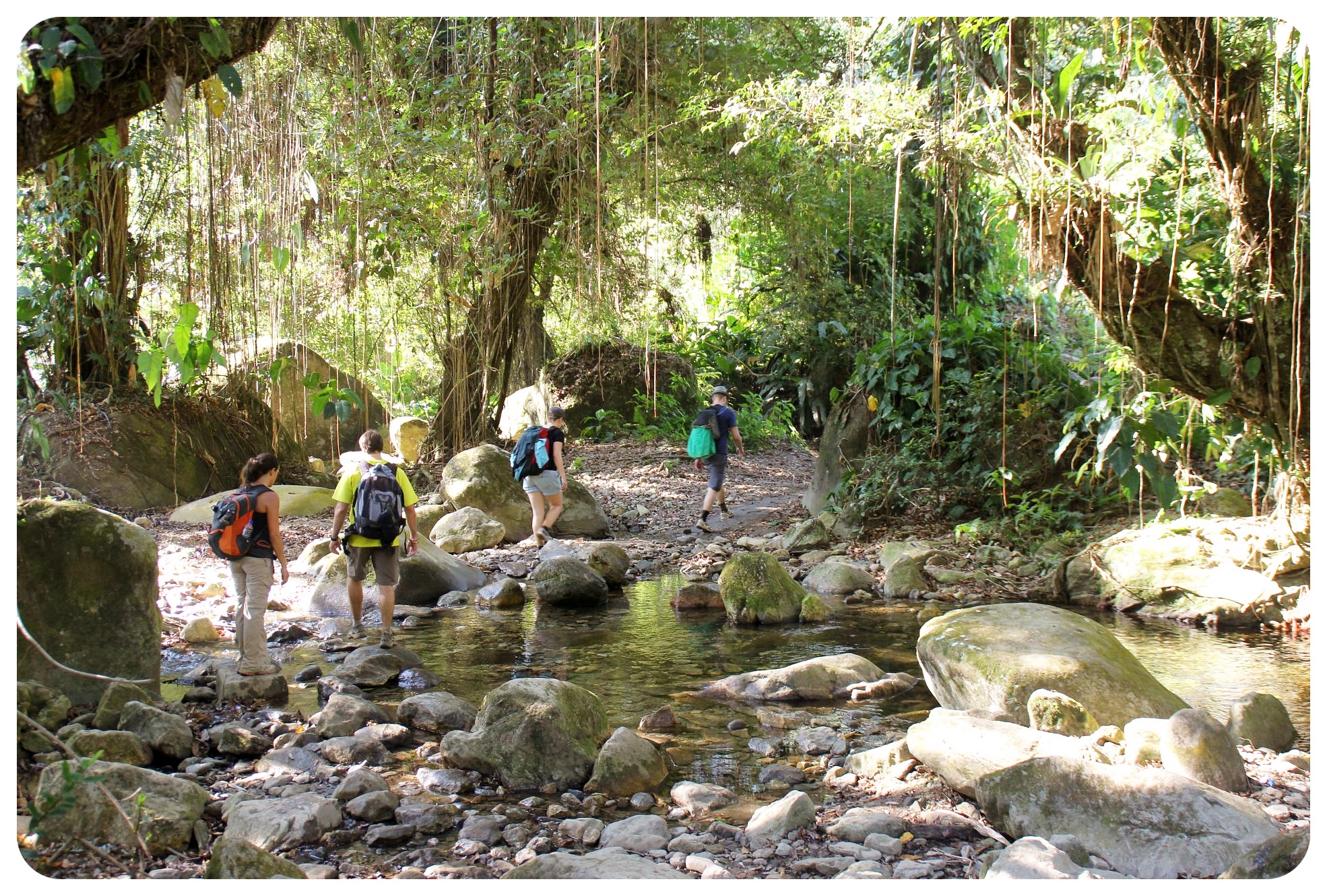 After all these swim breaks, I started thinking this day was actually pretty easy – but oh was I wrong. After our quick dip, we started a grueling climb up a steep mountainside, which lasted over an hour. By the time I made it to the mountaintop, I was panting like a dog and my calves were burning.
After all these swim breaks, I started thinking this day was actually pretty easy – but oh was I wrong. After our quick dip, we started a grueling climb up a steep mountainside, which lasted over an hour. By the time I made it to the mountaintop, I was panting like a dog and my calves were burning.
Much to my surprise, our kitchen crew had already reached the mountain top and handed everyone a slice of watermelon as they arrived on the top, sweat running down their faces.
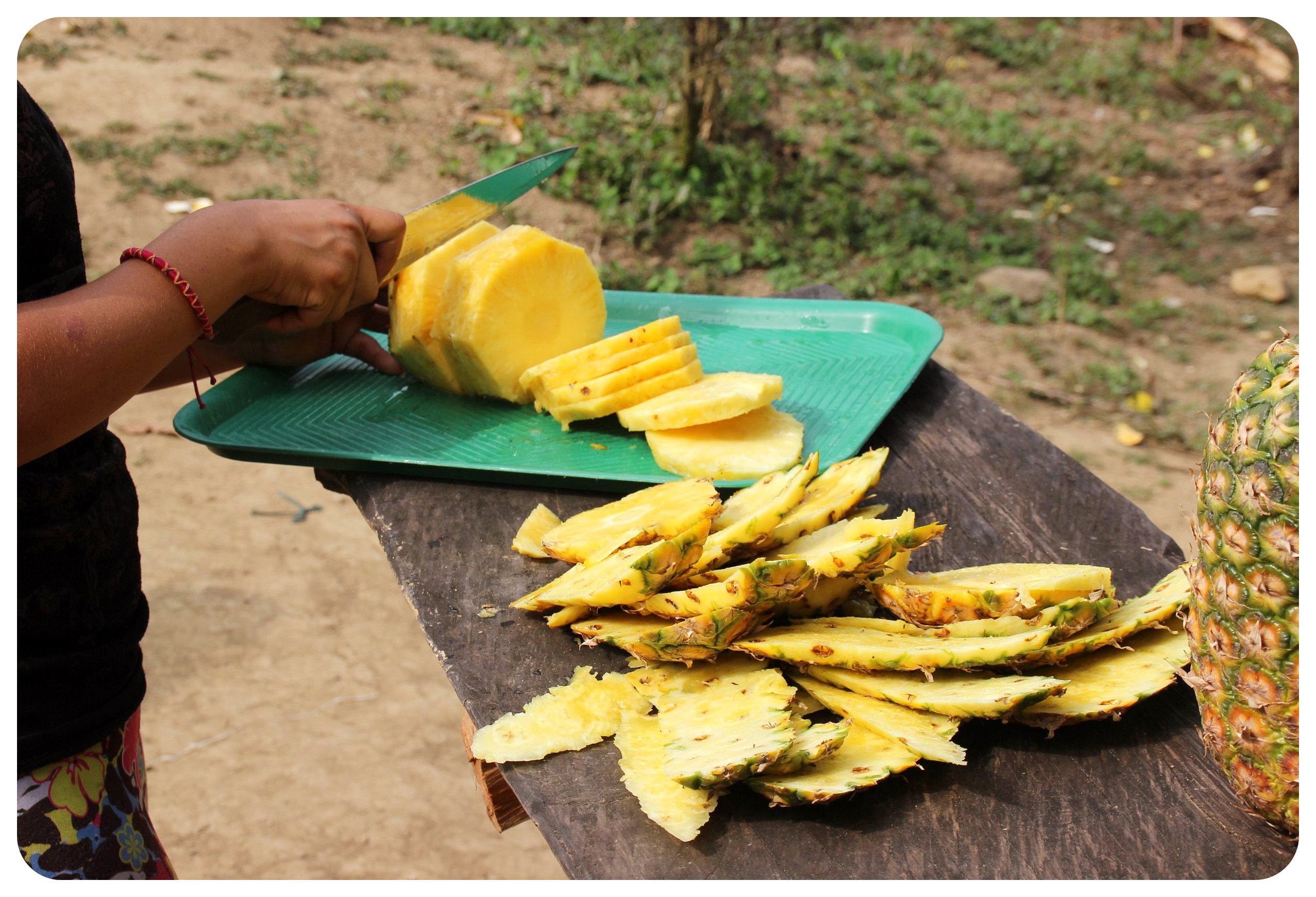 After this tiring climb, the hike got slightly easier (less steep), and an hour later we reached our camp for the night. This camp, Campo Paraiso, is the biggest camp. While the several tour companies that offer the Lost City trek each have their own camps along the trail, here, all the groups come together, and the camp had just been extended to accommodate more hikers – showing just how popular the hike to the Lost City had become.
After this tiring climb, the hike got slightly easier (less steep), and an hour later we reached our camp for the night. This camp, Campo Paraiso, is the biggest camp. While the several tour companies that offer the Lost City trek each have their own camps along the trail, here, all the groups come together, and the camp had just been extended to accommodate more hikers – showing just how popular the hike to the Lost City had become.
However, compared to the one million visitors Machu Picchu sees every year, the 8,500 adventurers who make their way to Colombia’s La Ciudad Perdida seem almost irrelevant in comparison.
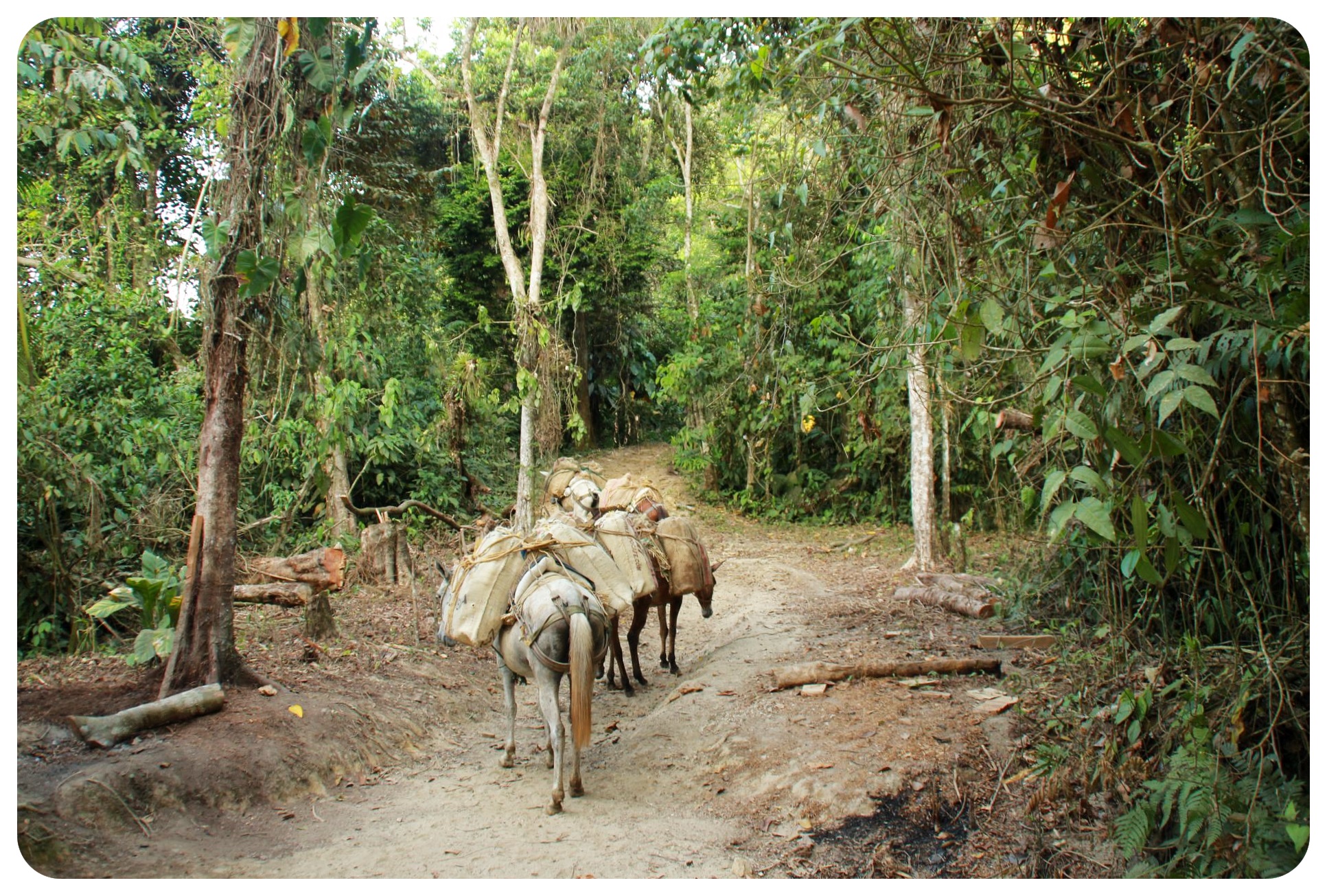 It was only one kilometer, 0.6 miles, to the Lost City from Campo Paraiso, but we wouldn’t get there until the next morning. Some of us still had the energy for an afternoon swim, because luckily, the camp was next to the river again, but nobody had the energy for the 1,200 stairs we still had to conquer before reaching the fabled city. By 8pm, we were all in bed, falling asleep to the sound of the jungle: birds, monkeys and other animals.
It was only one kilometer, 0.6 miles, to the Lost City from Campo Paraiso, but we wouldn’t get there until the next morning. Some of us still had the energy for an afternoon swim, because luckily, the camp was next to the river again, but nobody had the energy for the 1,200 stairs we still had to conquer before reaching the fabled city. By 8pm, we were all in bed, falling asleep to the sound of the jungle: birds, monkeys and other animals.
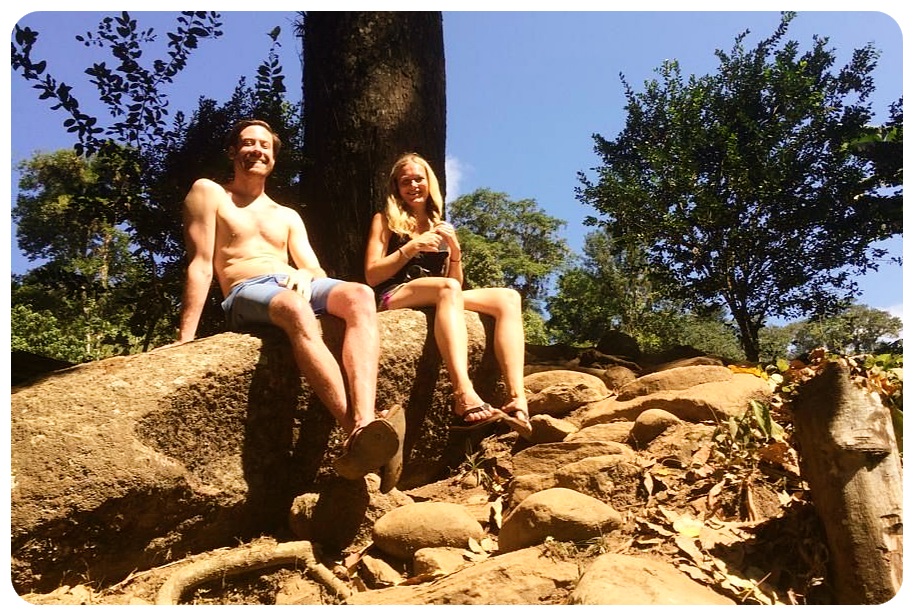 We were up bright and early at 5am again because today would be a long day: Not only would we finally visit the Lost City, but we’d also return to Camp 2, a three hour hike from Camp 3. The path we followed on our last morning followed the river, but we didn’t walk very far. Our guide suddenly stopped and we crossed the river. We had reached the bottom of the steep mountain on whose top the Lost City sits. Only 1,241 stairs were between us and our final destination now.
We were up bright and early at 5am again because today would be a long day: Not only would we finally visit the Lost City, but we’d also return to Camp 2, a three hour hike from Camp 3. The path we followed on our last morning followed the river, but we didn’t walk very far. Our guide suddenly stopped and we crossed the river. We had reached the bottom of the steep mountain on whose top the Lost City sits. Only 1,241 stairs were between us and our final destination now.
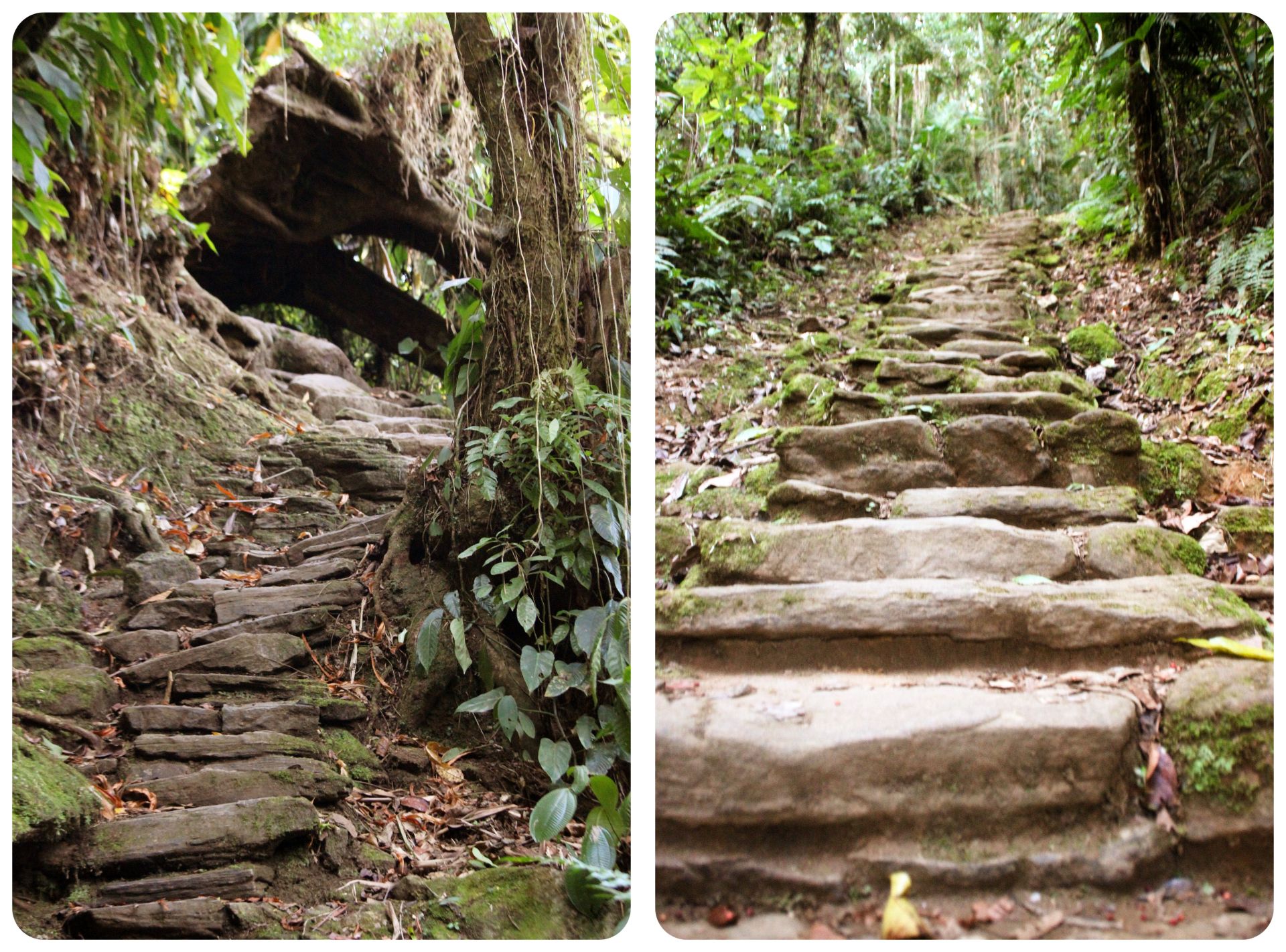 I couldn’t wait to finally see the Lost City, but anxious about the stairs. And when I say stairs, I am not talking about a proper staircase – the stairs we were climbing were centuries old, wonky and uneven stone stairs, carved out of rock.
I couldn’t wait to finally see the Lost City, but anxious about the stairs. And when I say stairs, I am not talking about a proper staircase – the stairs we were climbing were centuries old, wonky and uneven stone stairs, carved out of rock.
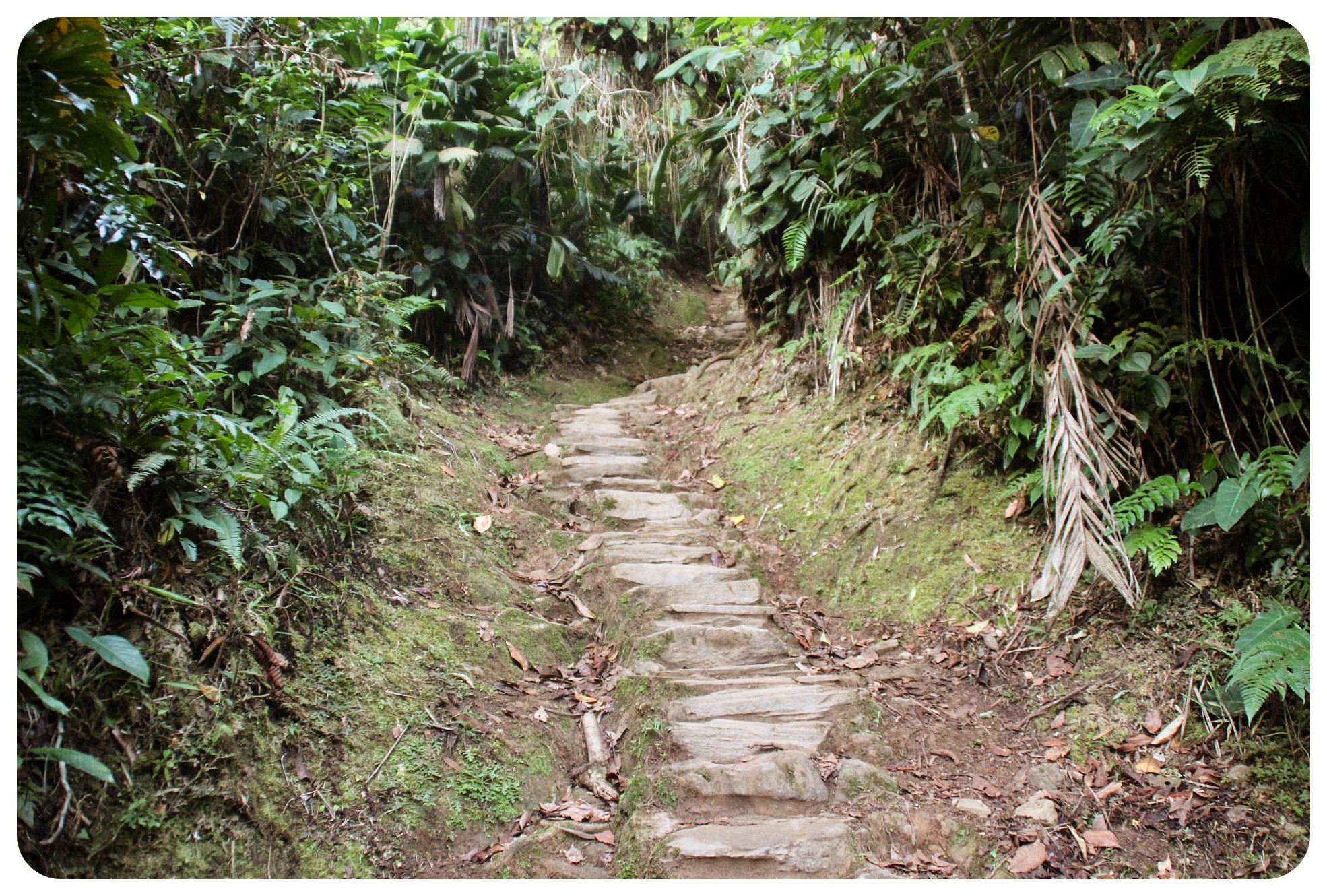 Sometimes, the stairs were so high that it took some serious effort to climb them. Considering the short size of the Wiwa people we met along the way it made me wonder how often they had to climb these stairs and how they managed to do it.
Sometimes, the stairs were so high that it took some serious effort to climb them. Considering the short size of the Wiwa people we met along the way it made me wonder how often they had to climb these stairs and how they managed to do it.
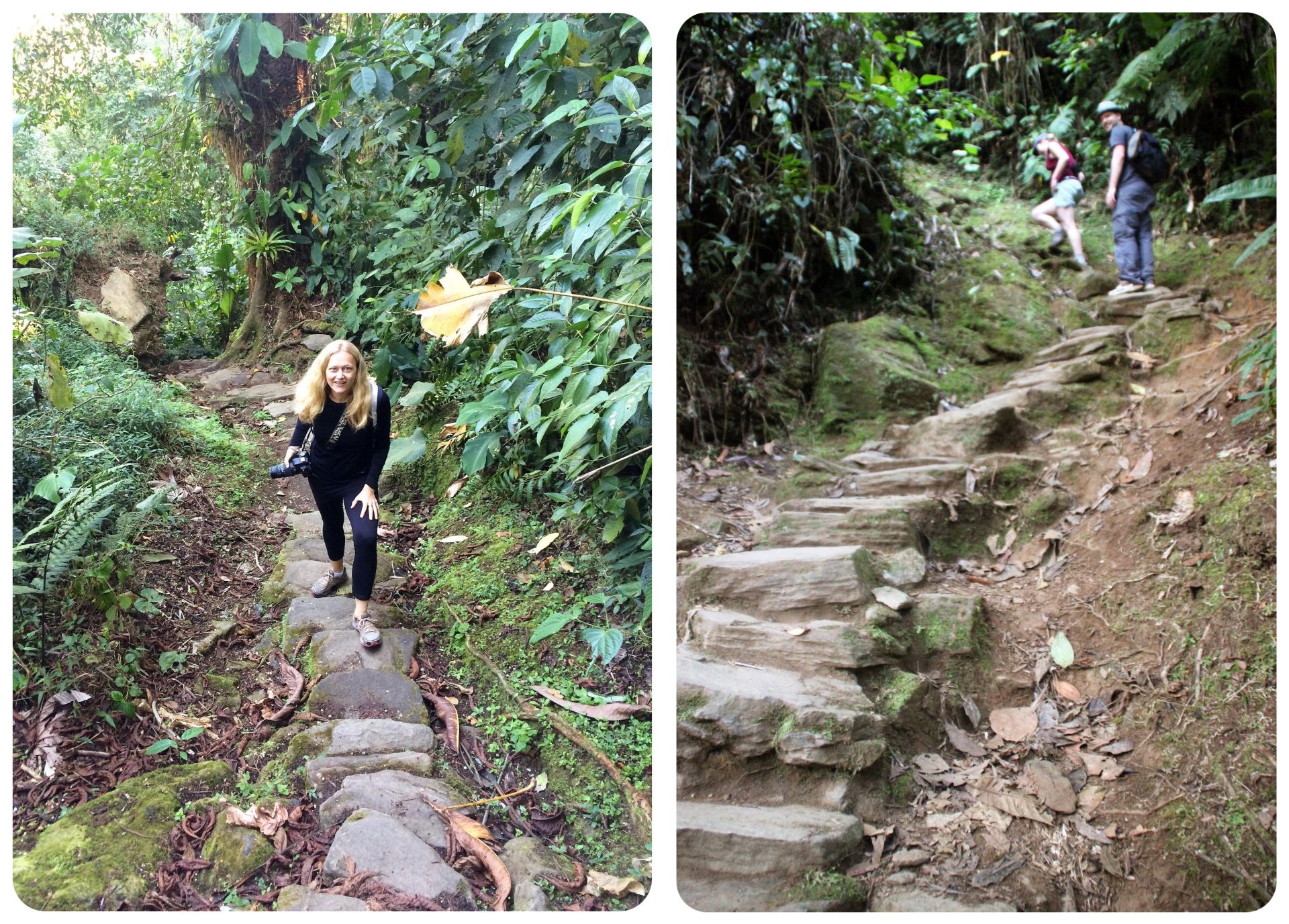 After an hour long climb, we finally made it to La Ciudad Perdida. It was an unforgettable moment when we finally reached the top of the stairs, and the jungle gave way to a plateau on which the first ruins of ancient houses sat.
After an hour long climb, we finally made it to La Ciudad Perdida. It was an unforgettable moment when we finally reached the top of the stairs, and the jungle gave way to a plateau on which the first ruins of ancient houses sat.
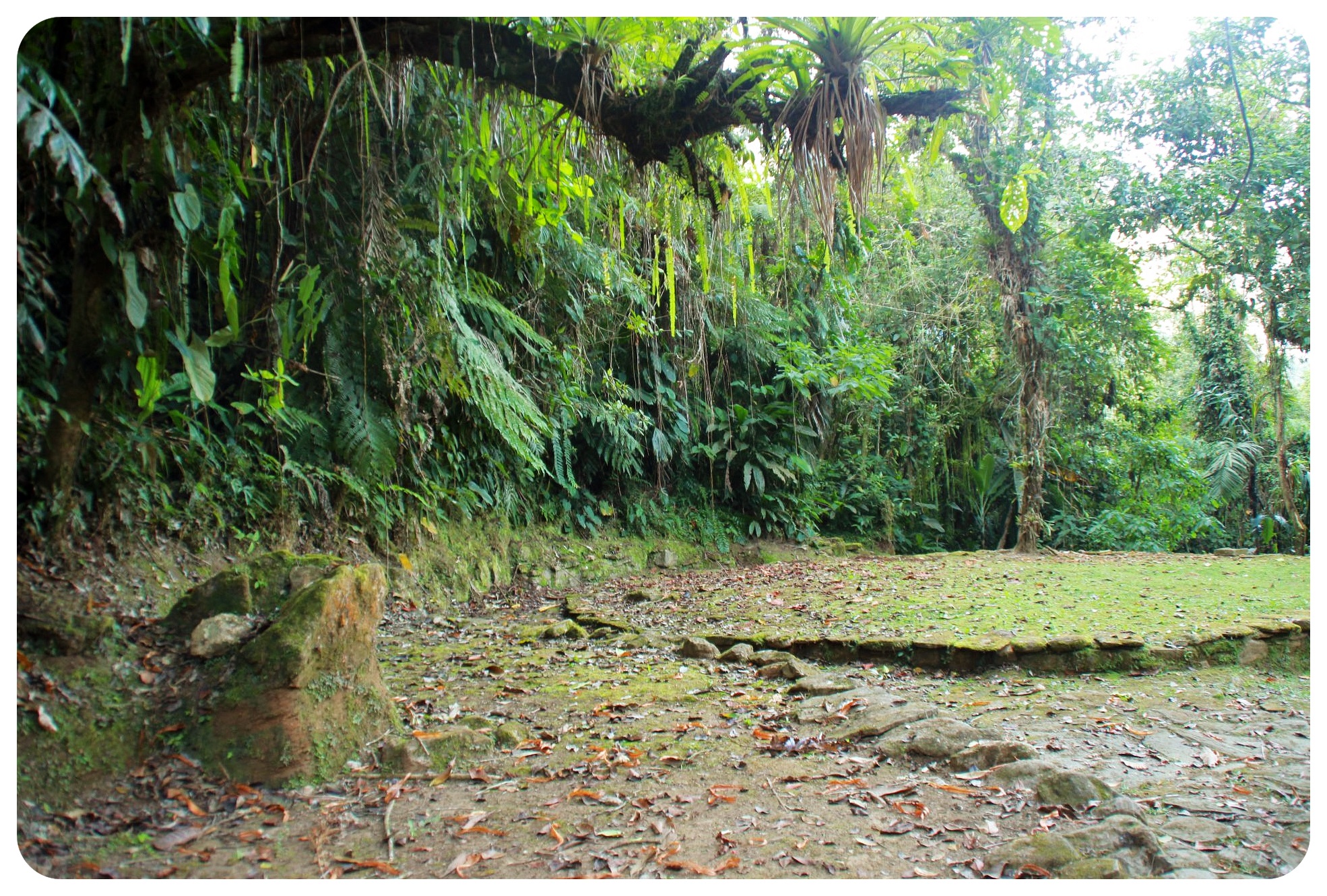 Teyuna, the name that was given to the city by archeologists, was built in AD 700, which makes it at least 600 years older than Machu Picchu. The site was abandoned in the 1600s and only in the early 1970s treasure hunters found the ruins and ransacked the then unnamed and undocumented city, emptying burial plots that were filled with golden jewelry and pottery. It took until 1976 for the news of its discovery to get out and for archeologists to arrive to the site. Over the course of the next six years, until 1982, Teyuna was excavated and restored.
Teyuna, the name that was given to the city by archeologists, was built in AD 700, which makes it at least 600 years older than Machu Picchu. The site was abandoned in the 1600s and only in the early 1970s treasure hunters found the ruins and ransacked the then unnamed and undocumented city, emptying burial plots that were filled with golden jewelry and pottery. It took until 1976 for the news of its discovery to get out and for archeologists to arrive to the site. Over the course of the next six years, until 1982, Teyuna was excavated and restored.
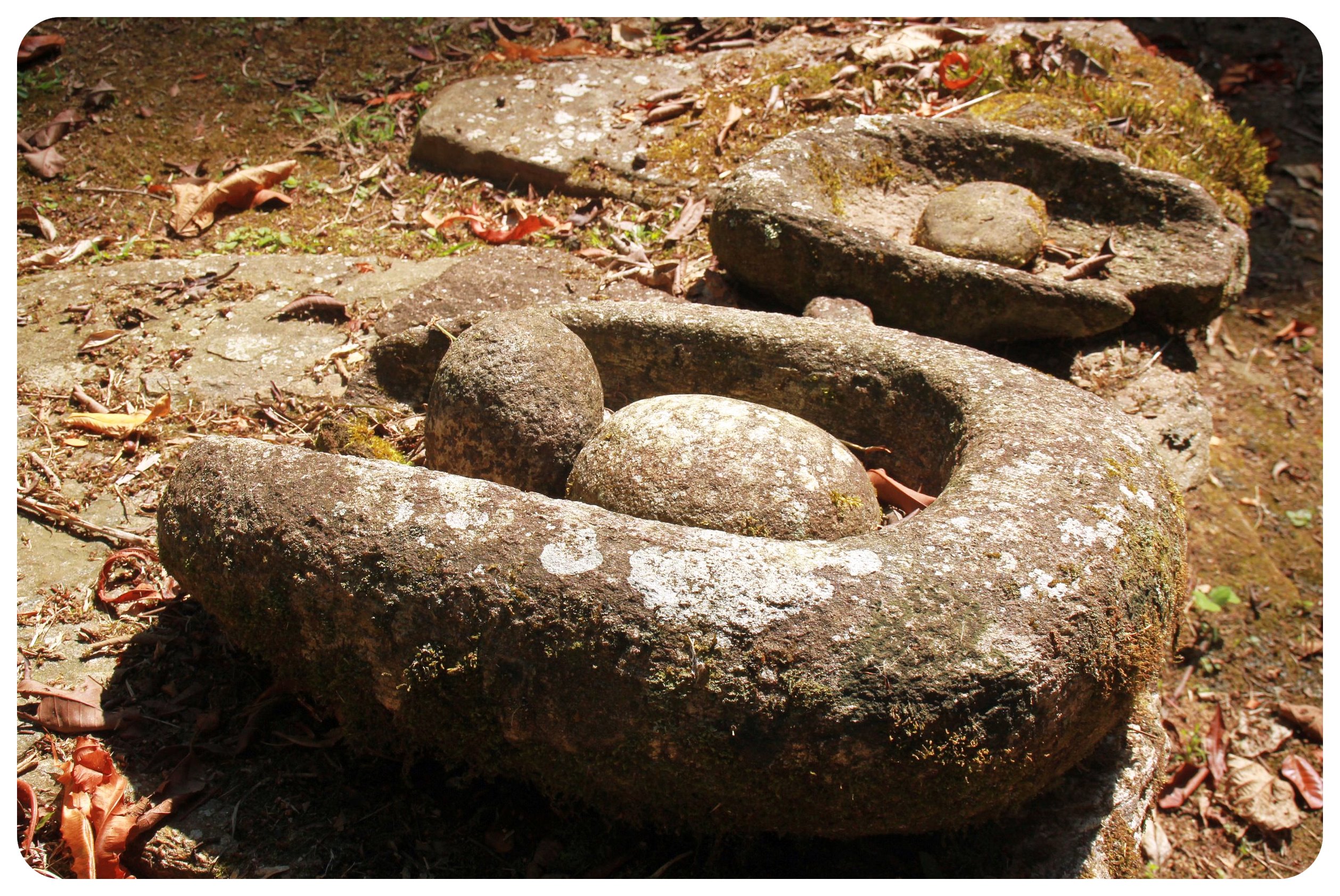 The city was built high up on the mountain to be closer to Wymaco, the father of gods. For the Wiwa people this is still a sacred site, and for two weeks every September, descendants of the Teyuna gather here for ceremonies.
The city was built high up on the mountain to be closer to Wymaco, the father of gods. For the Wiwa people this is still a sacred site, and for two weeks every September, descendants of the Teyuna gather here for ceremonies.
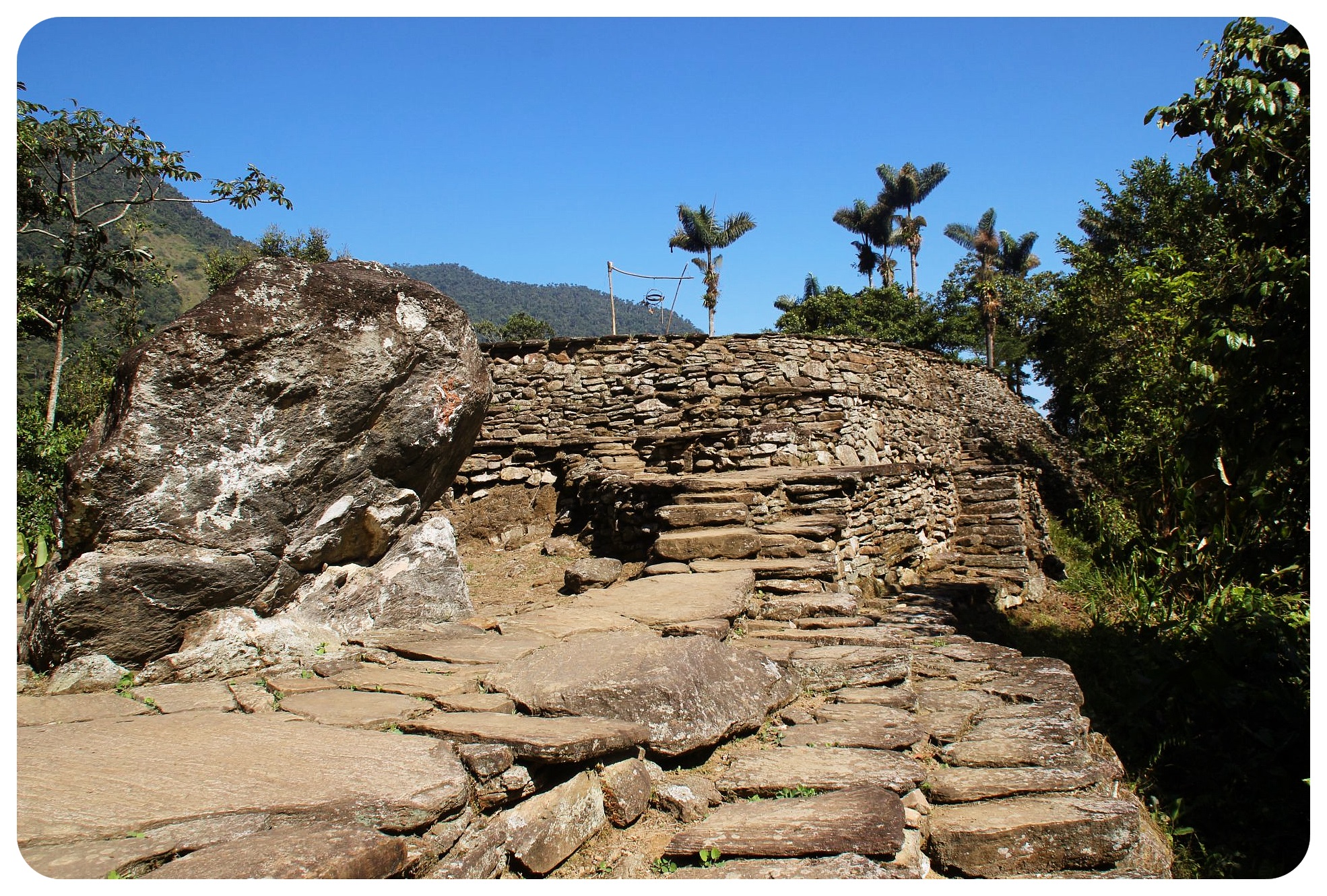 It felt amazing to have the entire city to ourselves, basking in the mystical aura it emitted. There was only one other group of five people that arrived at the Lost City the same day as we did, and we only saw them once while we explored the city. To think we were the only ones here, in this sacred place far away from any civilization, made the experience even more special.
It felt amazing to have the entire city to ourselves, basking in the mystical aura it emitted. There was only one other group of five people that arrived at the Lost City the same day as we did, and we only saw them once while we explored the city. To think we were the only ones here, in this sacred place far away from any civilization, made the experience even more special.
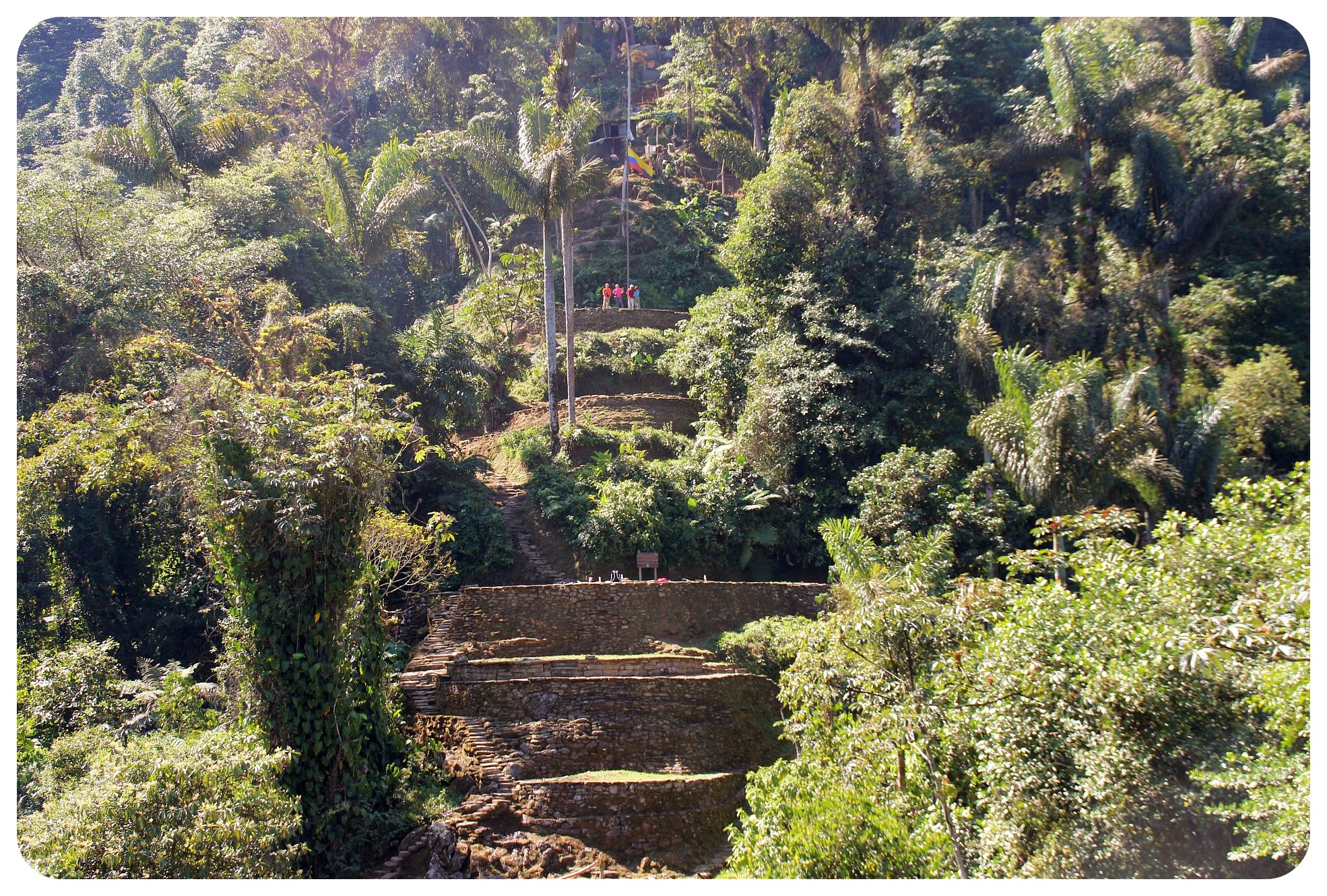 I was surprised when I realized how big La Ciudad Perdida was, since most of the brochures and travel guides only feature the same image:
I was surprised when I realized how big La Ciudad Perdida was, since most of the brochures and travel guides only feature the same image:
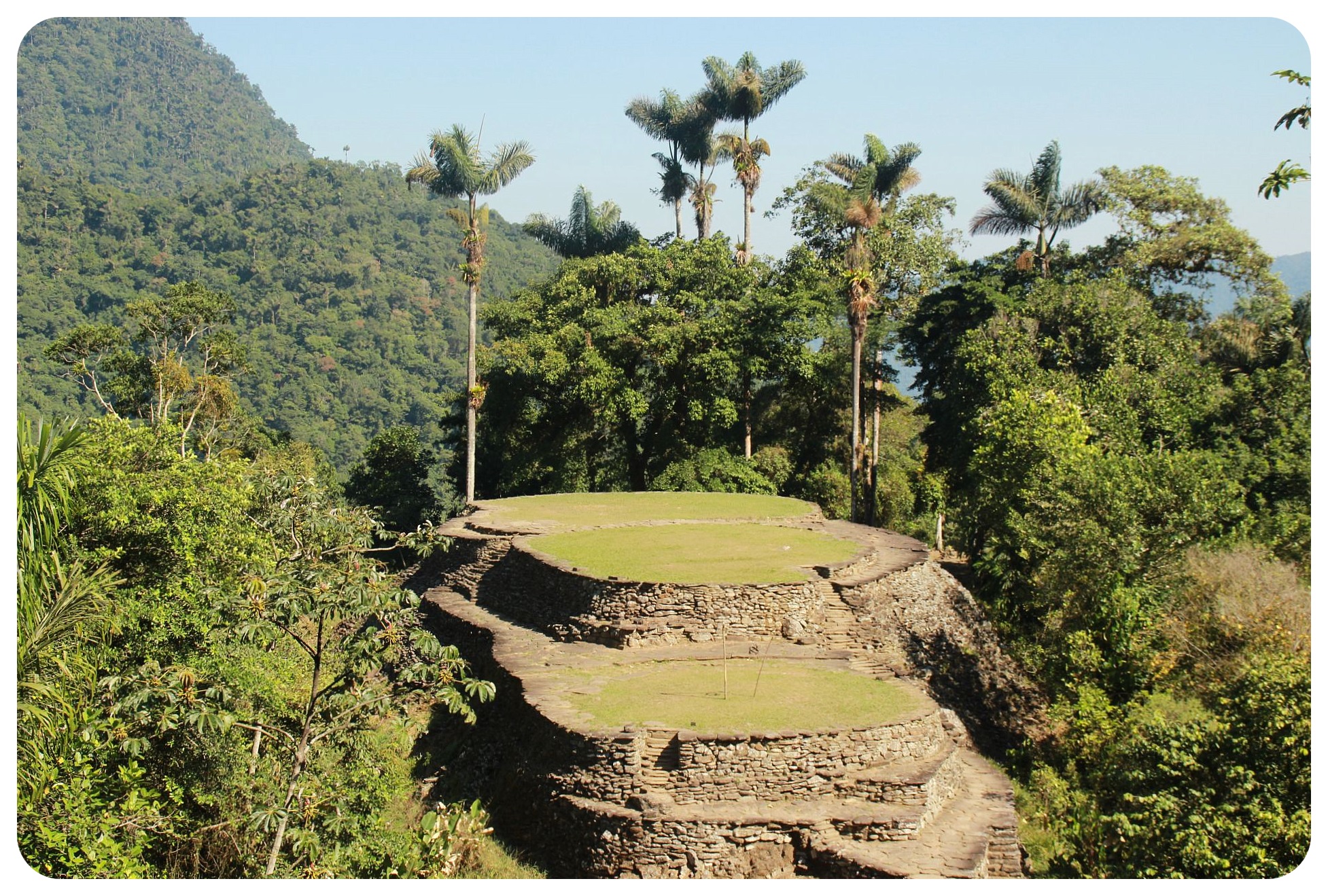 But there’s so much more to the Lost City – a myriad of staircases that lead to several terraces clinging to the mountainside, the foundations of houses still well recognizable everywhere. There used to be 1,000 houses here, and archeologists estimate between 1,300 and 3,000 people lived here.
But there’s so much more to the Lost City – a myriad of staircases that lead to several terraces clinging to the mountainside, the foundations of houses still well recognizable everywhere. There used to be 1,000 houses here, and archeologists estimate between 1,300 and 3,000 people lived here.
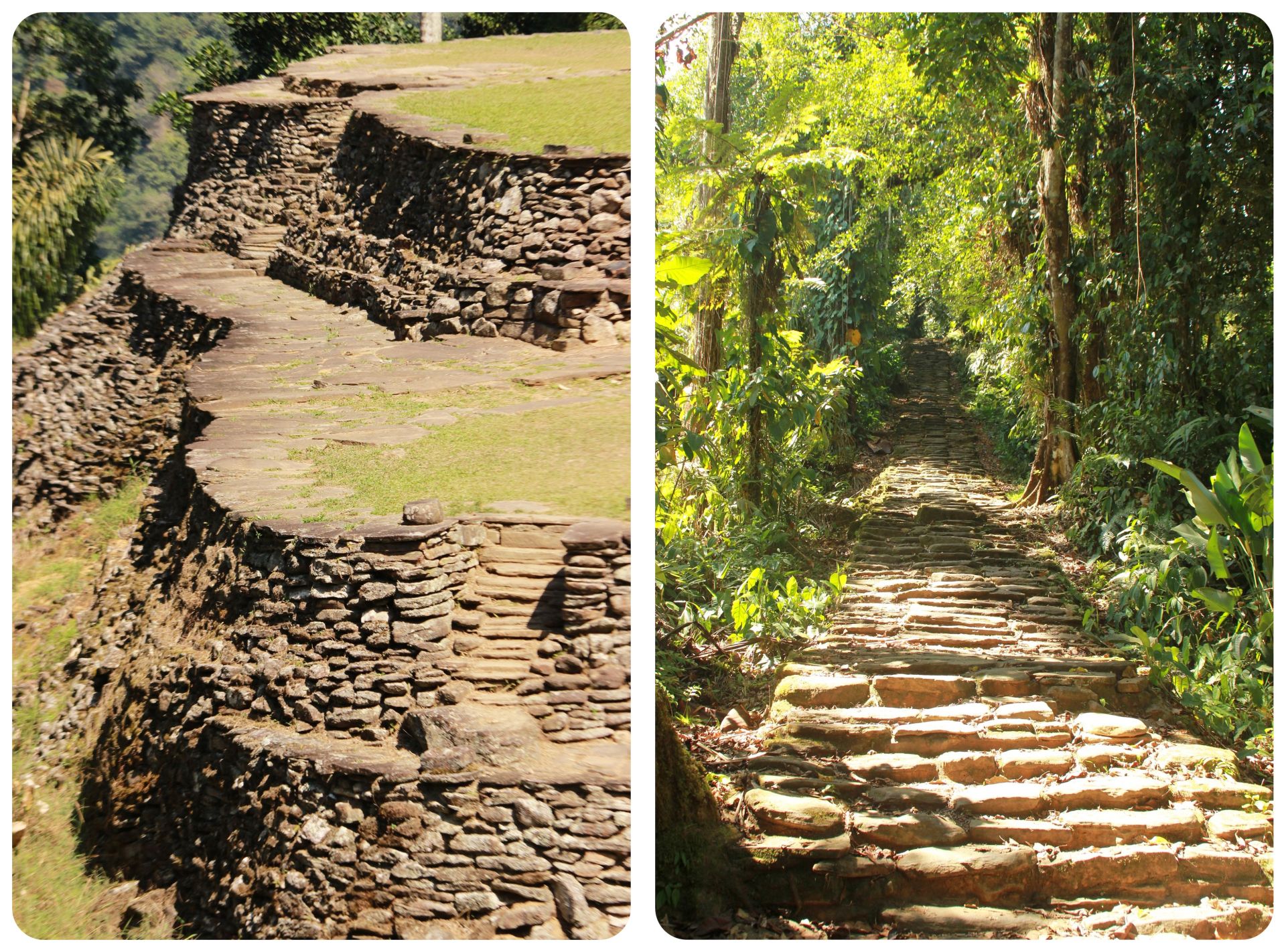 We explored the city, which spreads out over 86 acres, for several hours, walking between the moss-covered old rocks, ruins of people’s homes, plazas and ruins of temples. There are 169 circular terraces, and rocks on which maps were carved, all surrounded by the dense jungle which had hidden Teyuna for hundreds of years.
We explored the city, which spreads out over 86 acres, for several hours, walking between the moss-covered old rocks, ruins of people’s homes, plazas and ruins of temples. There are 169 circular terraces, and rocks on which maps were carved, all surrounded by the dense jungle which had hidden Teyuna for hundreds of years.
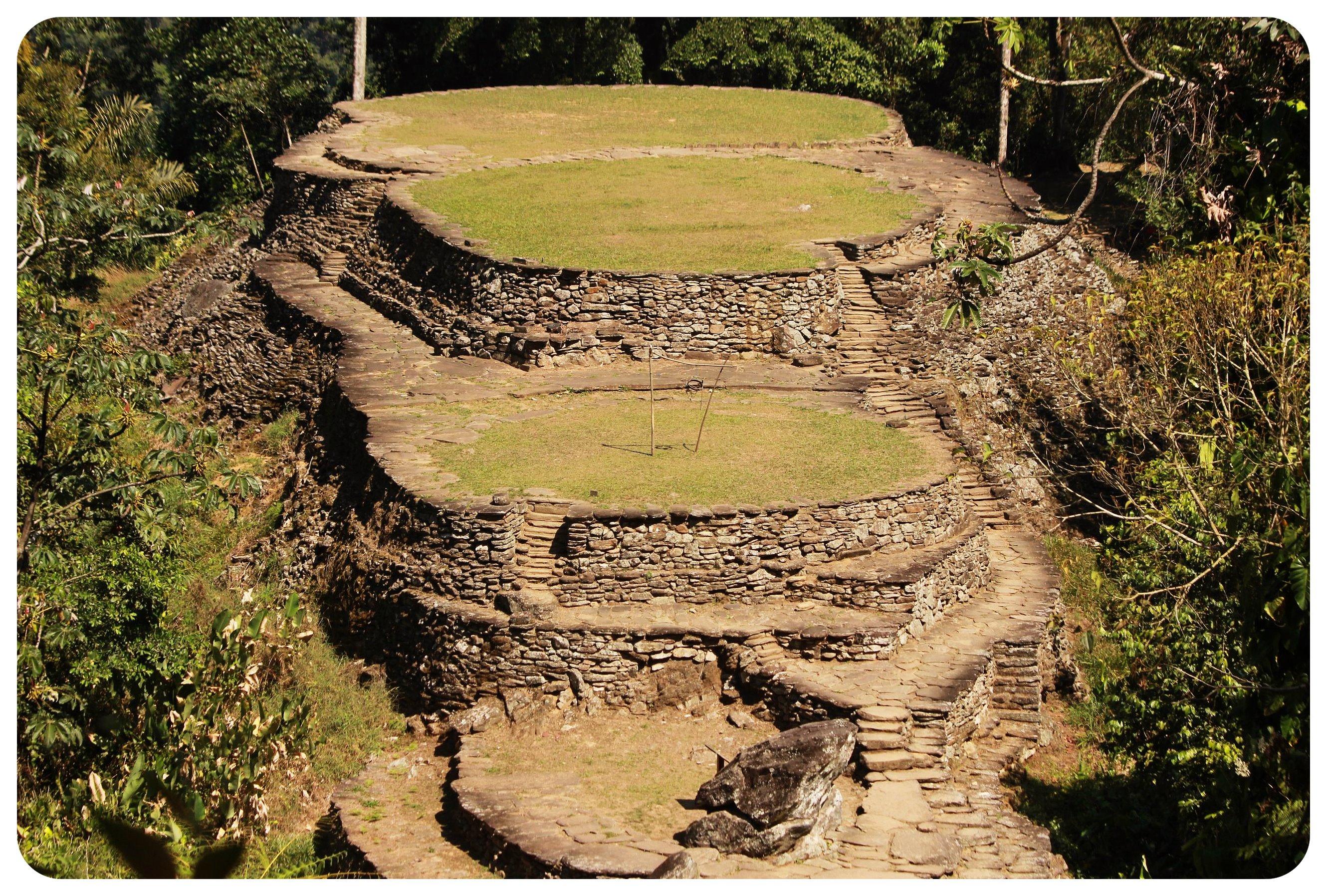 The highlight of the day was reaching the main terraces of the city, called La Capilla, which are sitting high up on a mountain top with sweeping views of the surrounding mountains, all covered in lush green tropical forests. We sat down at the edge of one of the terraces and took in the scenery around us. Nobody spoke, everyone was lost in their own thoughts.
The highlight of the day was reaching the main terraces of the city, called La Capilla, which are sitting high up on a mountain top with sweeping views of the surrounding mountains, all covered in lush green tropical forests. We sat down at the edge of one of the terraces and took in the scenery around us. Nobody spoke, everyone was lost in their own thoughts.
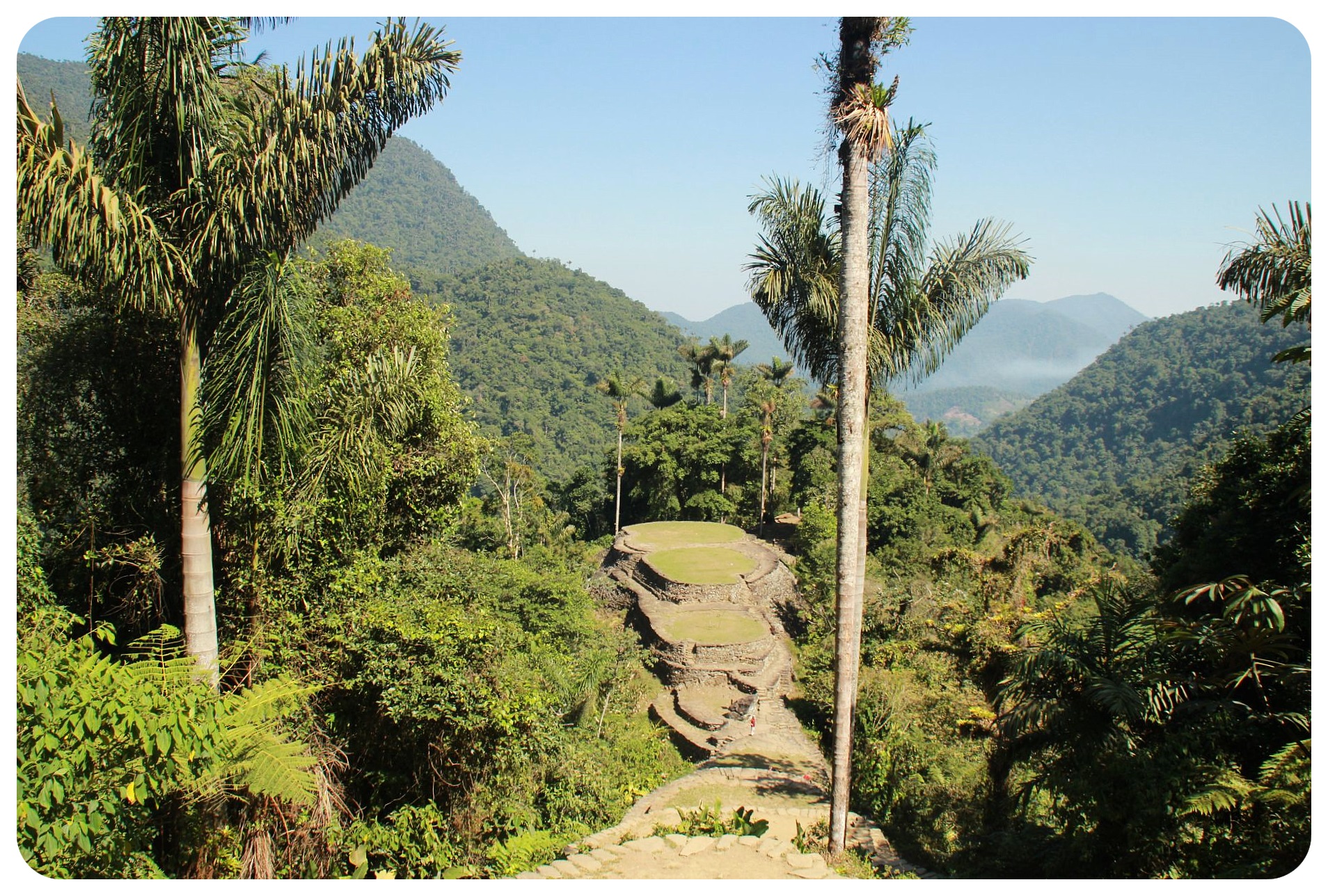 The Teyuna were a community of potters and farmers, and the city was connected to other cities in the mountains through a network of stone paths. There are similar cities still hidden in the jungle in the mountains here, waiting to be discovered.
The Teyuna were a community of potters and farmers, and the city was connected to other cities in the mountains through a network of stone paths. There are similar cities still hidden in the jungle in the mountains here, waiting to be discovered.
Archeologists are not one hundred percent sure why the Lost City was left, but presumably because diseases spread after the Spanish arrived in this region in the 16th century. It didn’t take long for the jungle to grow over the stone buildings, hiding it under its thick vines and a layer of moss.
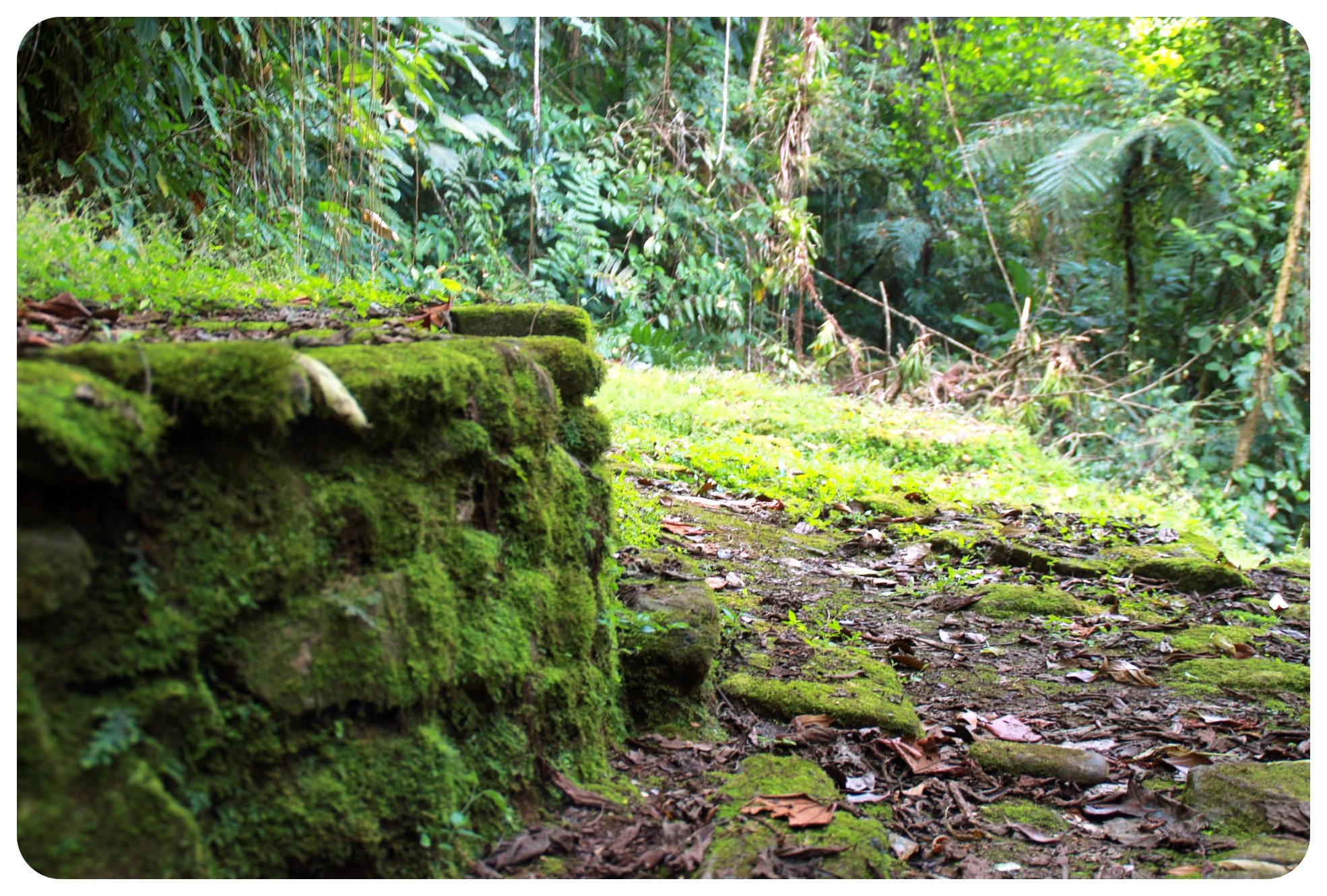 Not everything here is a ruin, however: we also passed a couple of houses in which a family lived. From the shaman of their community we learned that he was the head of 160 families who were living in the area, and for them not much had changed since the times of the Tayrona. The same basic huts, and with them living pretty self-sufficiently off of what the woods provided them with (mainly cocoa, fruits and tobacco).
Not everything here is a ruin, however: we also passed a couple of houses in which a family lived. From the shaman of their community we learned that he was the head of 160 families who were living in the area, and for them not much had changed since the times of the Tayrona. The same basic huts, and with them living pretty self-sufficiently off of what the woods provided them with (mainly cocoa, fruits and tobacco).
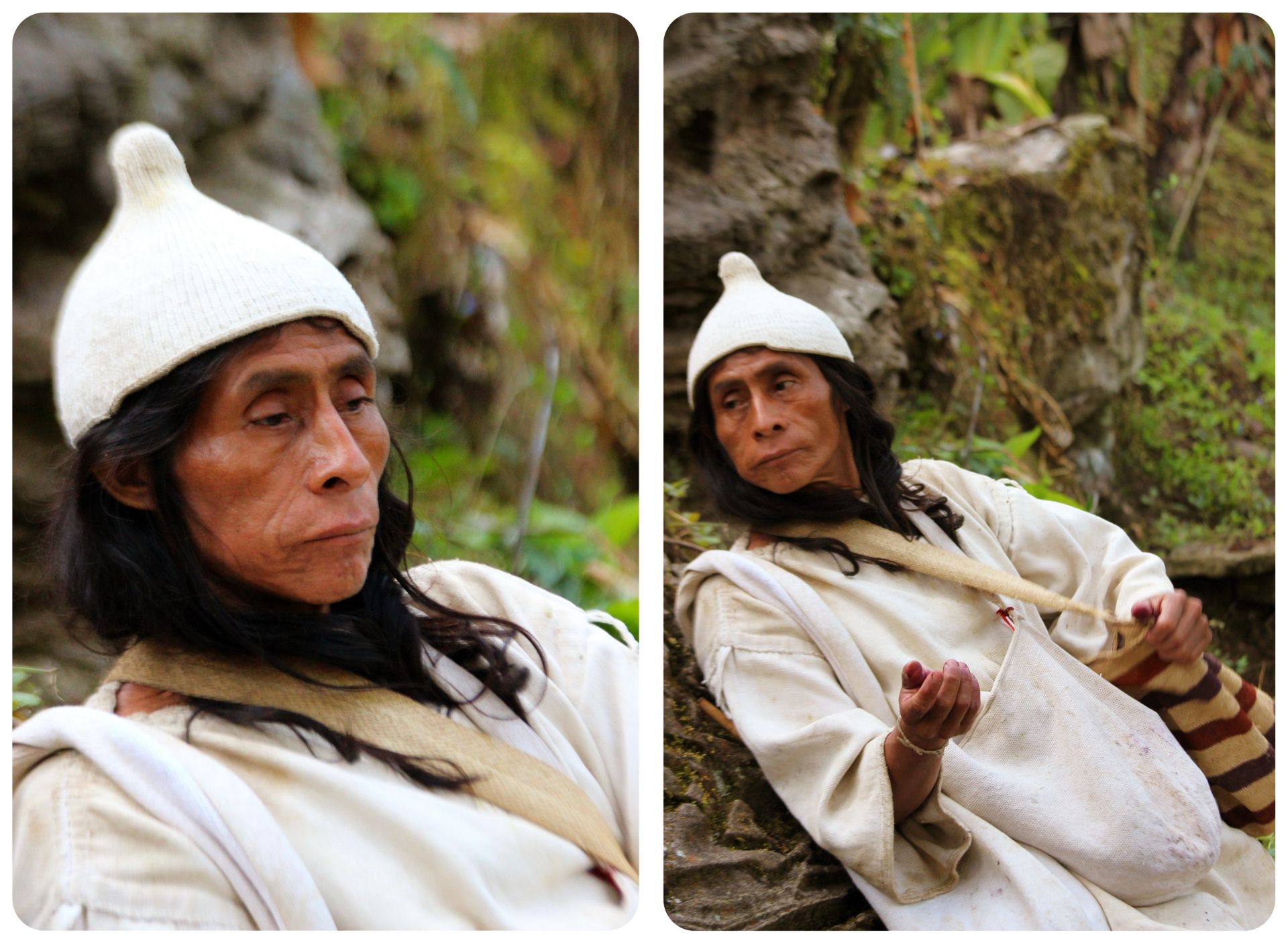 We left after receiving a protective bracelet from the shaman, but not without asking a dozen questions about his life and his family, curious to hear about life in the mountains.
We left after receiving a protective bracelet from the shaman, but not without asking a dozen questions about his life and his family, curious to hear about life in the mountains.
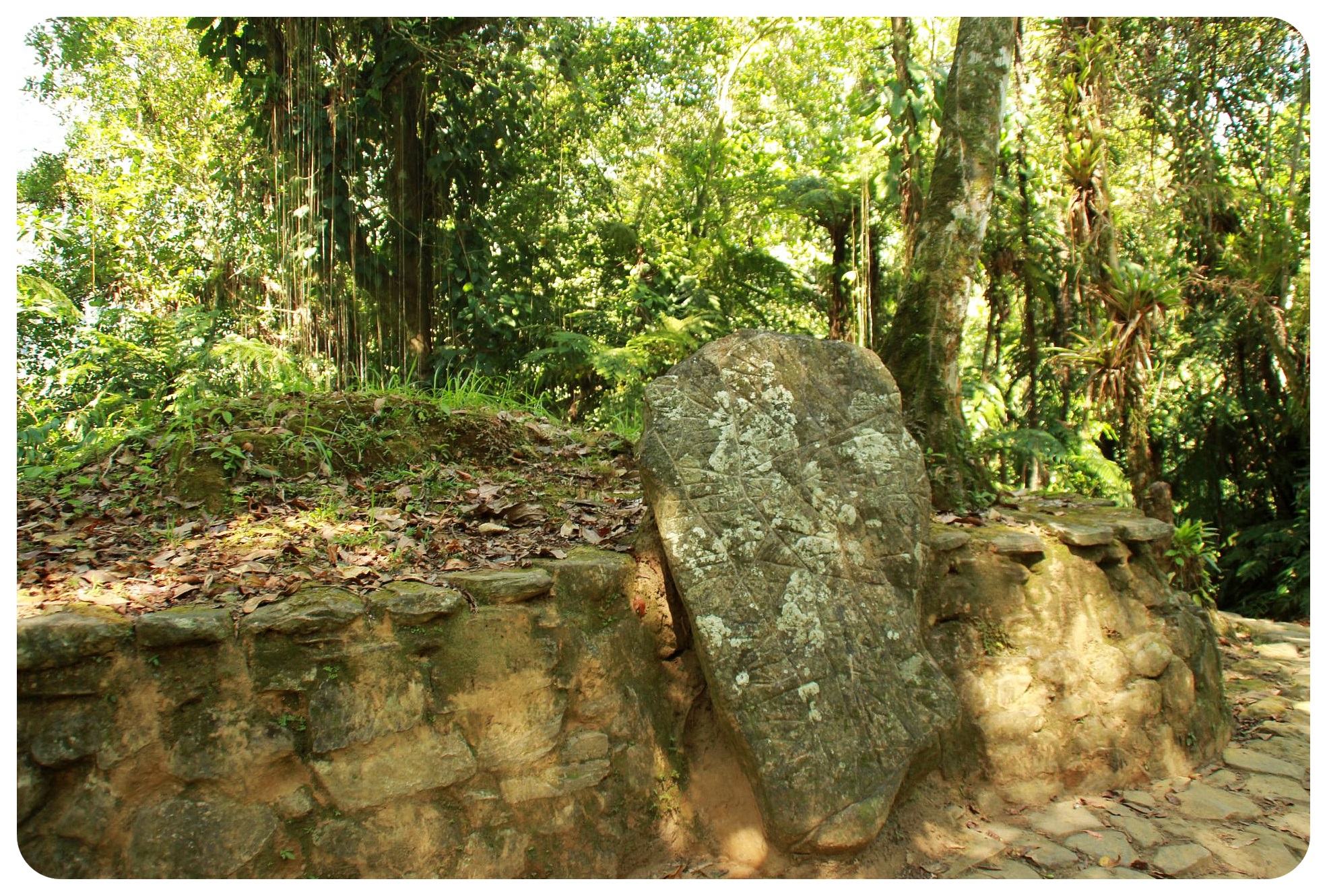 The biggest problem for them at the moment? Climate change. The past couple of years have been very dry, the rainy season in June and July is not bringing as much rain as they’re used to, which in turn affects their harvest.
The biggest problem for them at the moment? Climate change. The past couple of years have been very dry, the rainy season in June and July is not bringing as much rain as they’re used to, which in turn affects their harvest.
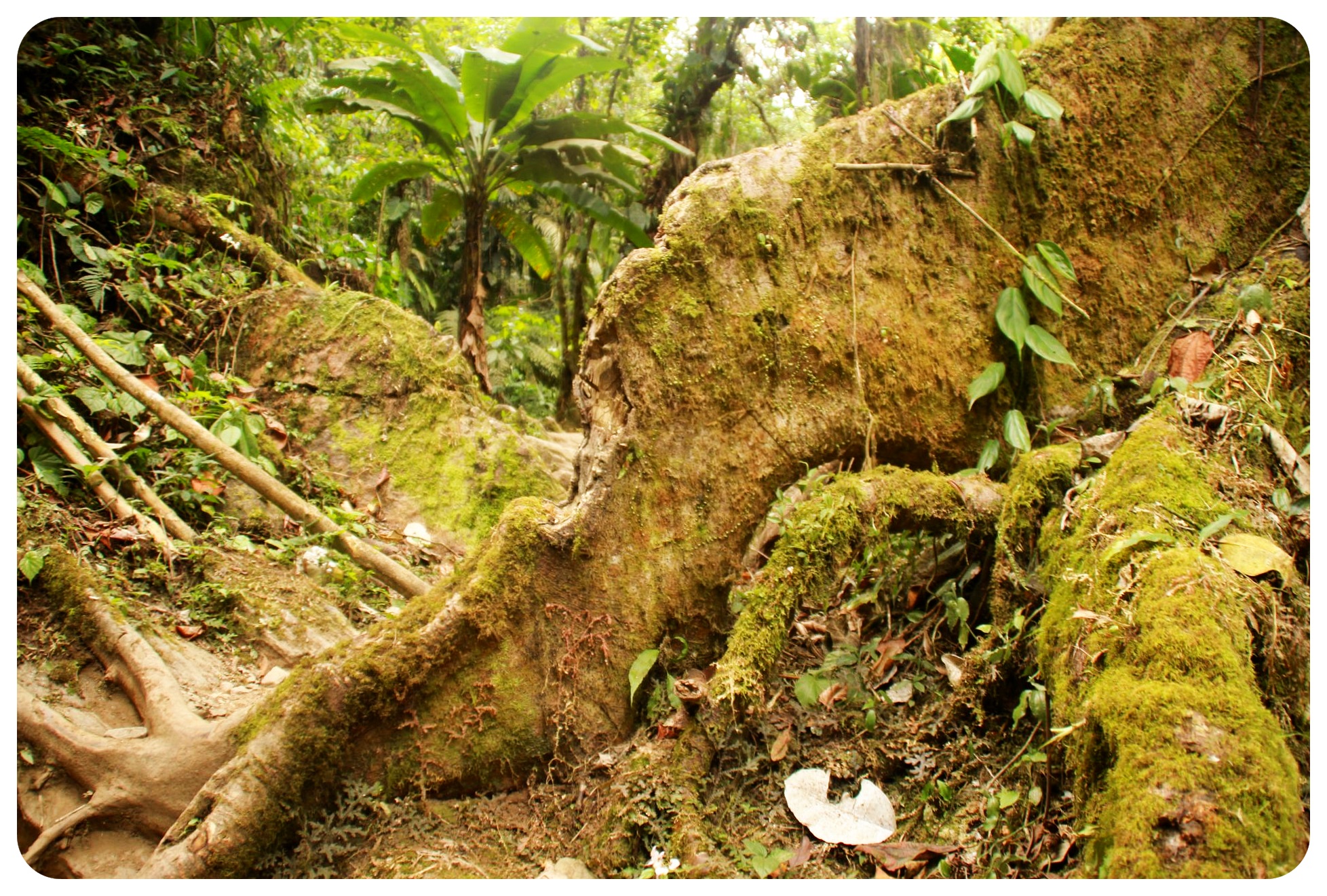 We also learned the reason for their long hair: The Wiwa people don’t cut their hair because they believe the brain breathes through the hair, and cutting your hair means cutting the oxygen to the brain.
We also learned the reason for their long hair: The Wiwa people don’t cut their hair because they believe the brain breathes through the hair, and cutting your hair means cutting the oxygen to the brain.
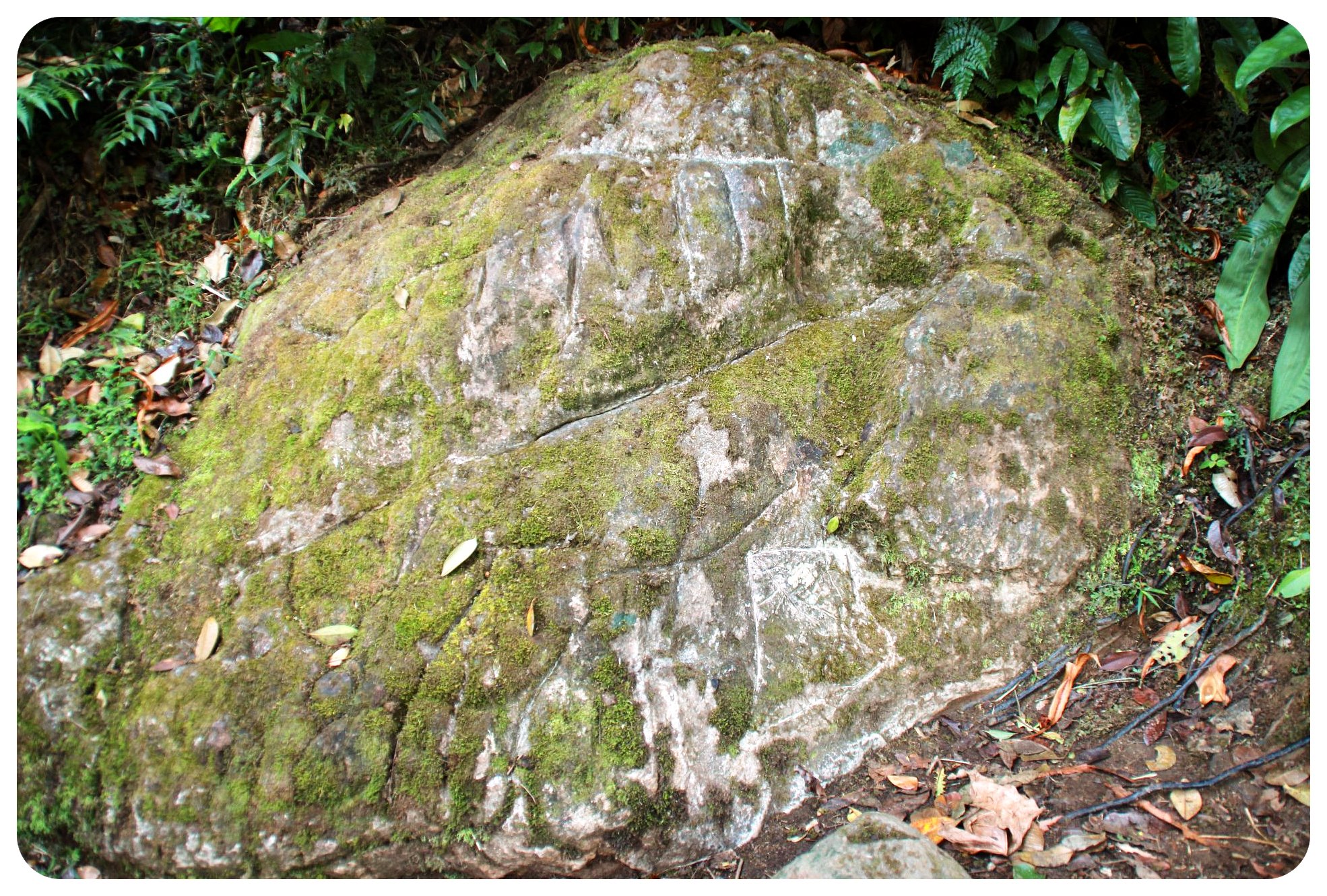 This might not be a Machu Picchu, but having hiked to Machu Picchu, I can say that this city was striking in its own way, and well worth the arduous trek.
This might not be a Machu Picchu, but having hiked to Machu Picchu, I can say that this city was striking in its own way, and well worth the arduous trek.
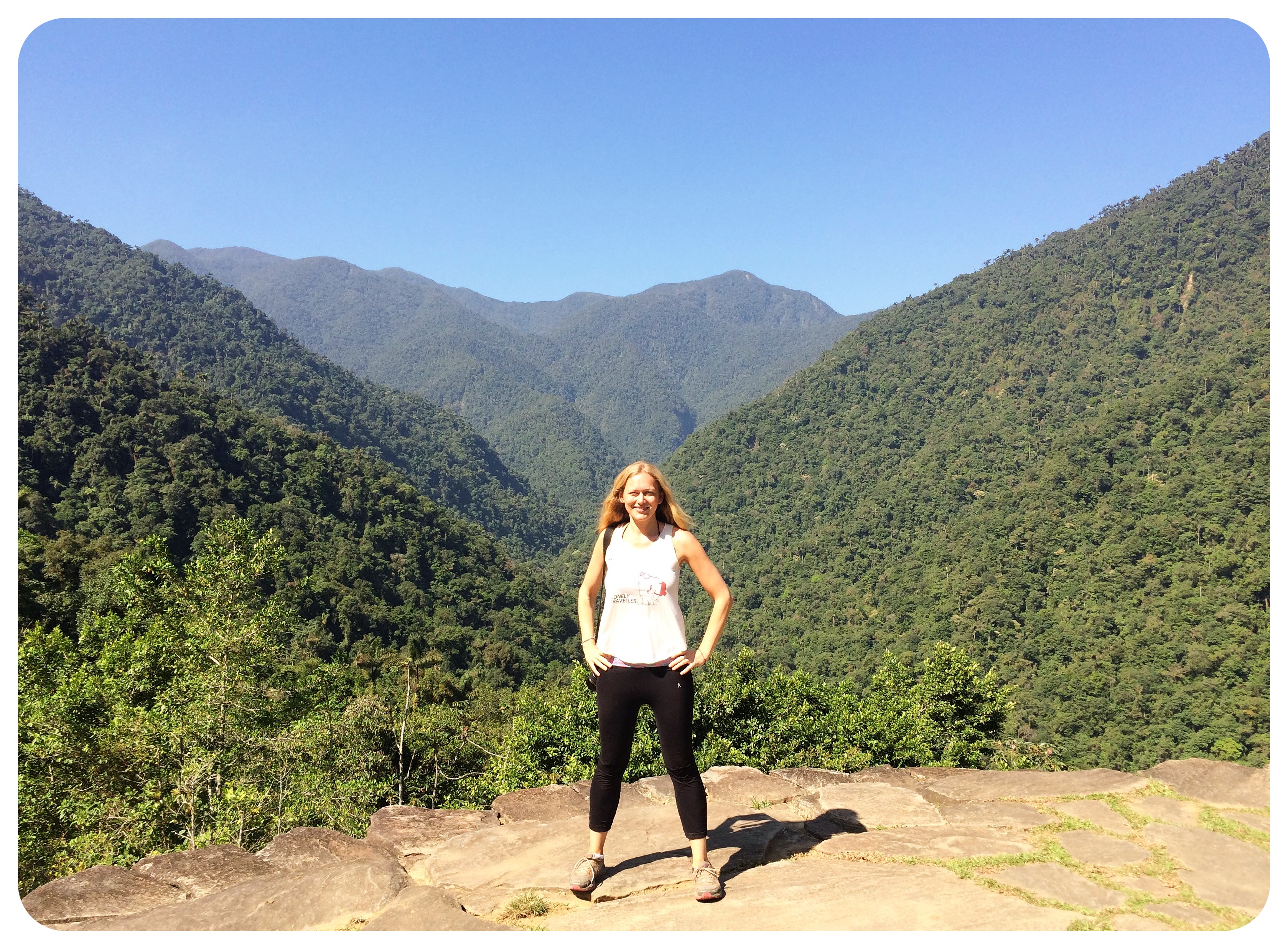 After spending the morning exploring the ruins, it was time to climb down the 1,200 stairs and to grab a quick lunch before walking back to Camp 2, where we would spend the night. But since this trip seemed to be just as much about swimming as it was about visiting the Lost City, there was time for a quick dip in the river.
After spending the morning exploring the ruins, it was time to climb down the 1,200 stairs and to grab a quick lunch before walking back to Camp 2, where we would spend the night. But since this trip seemed to be just as much about swimming as it was about visiting the Lost City, there was time for a quick dip in the river.
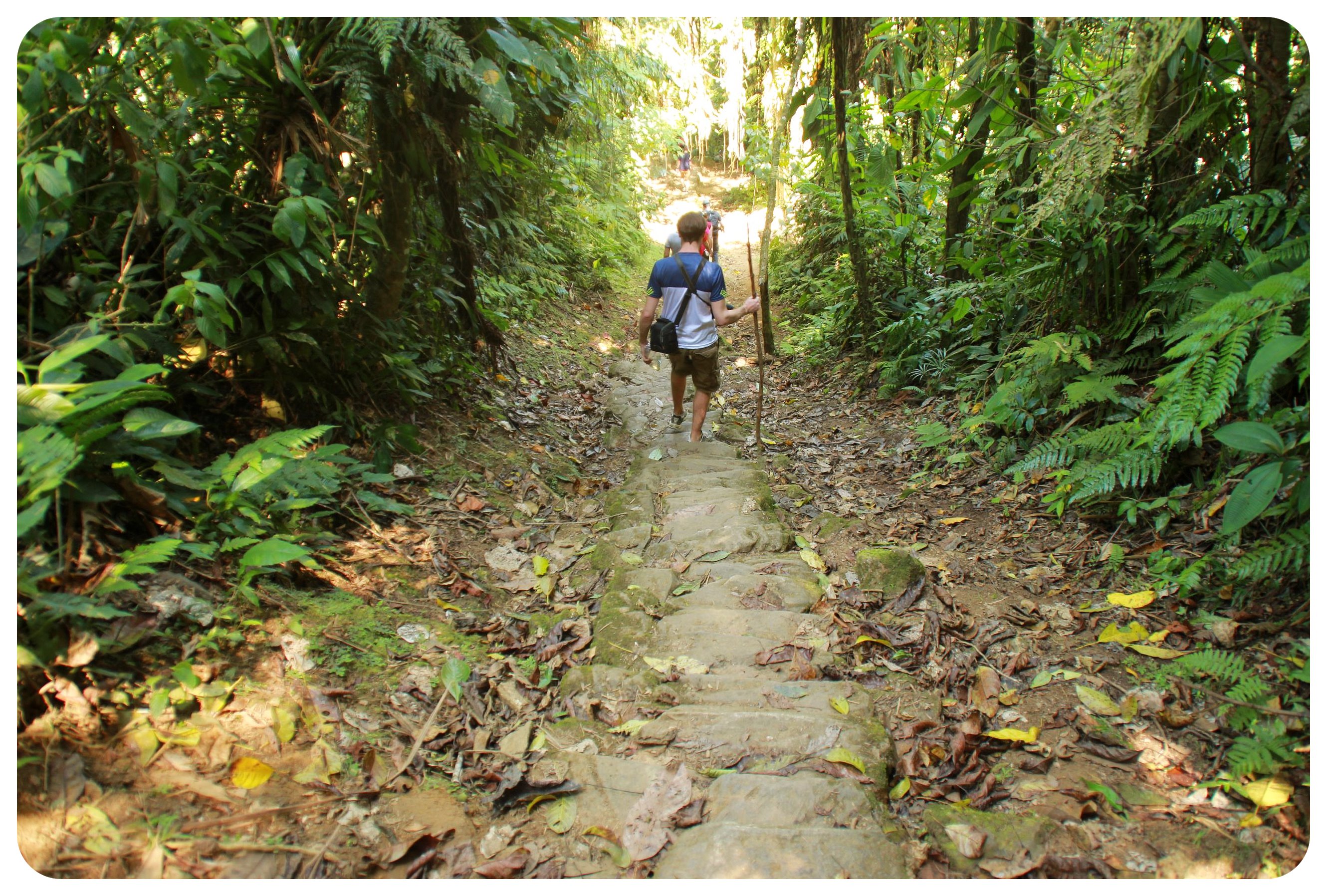 The trek back didn’t feel as grueling as the hike to the Lost City, because the one-hour climb from the day before was a much more enjoyable downhill hike now, and we even arrived in the camp early enough for a swim before sunset. Knowing we had another long day ahead of us, all of us were in bed by 8pm again, and I was asleep by 9pm.
The trek back didn’t feel as grueling as the hike to the Lost City, because the one-hour climb from the day before was a much more enjoyable downhill hike now, and we even arrived in the camp early enough for a swim before sunset. Knowing we had another long day ahead of us, all of us were in bed by 8pm again, and I was asleep by 9pm.
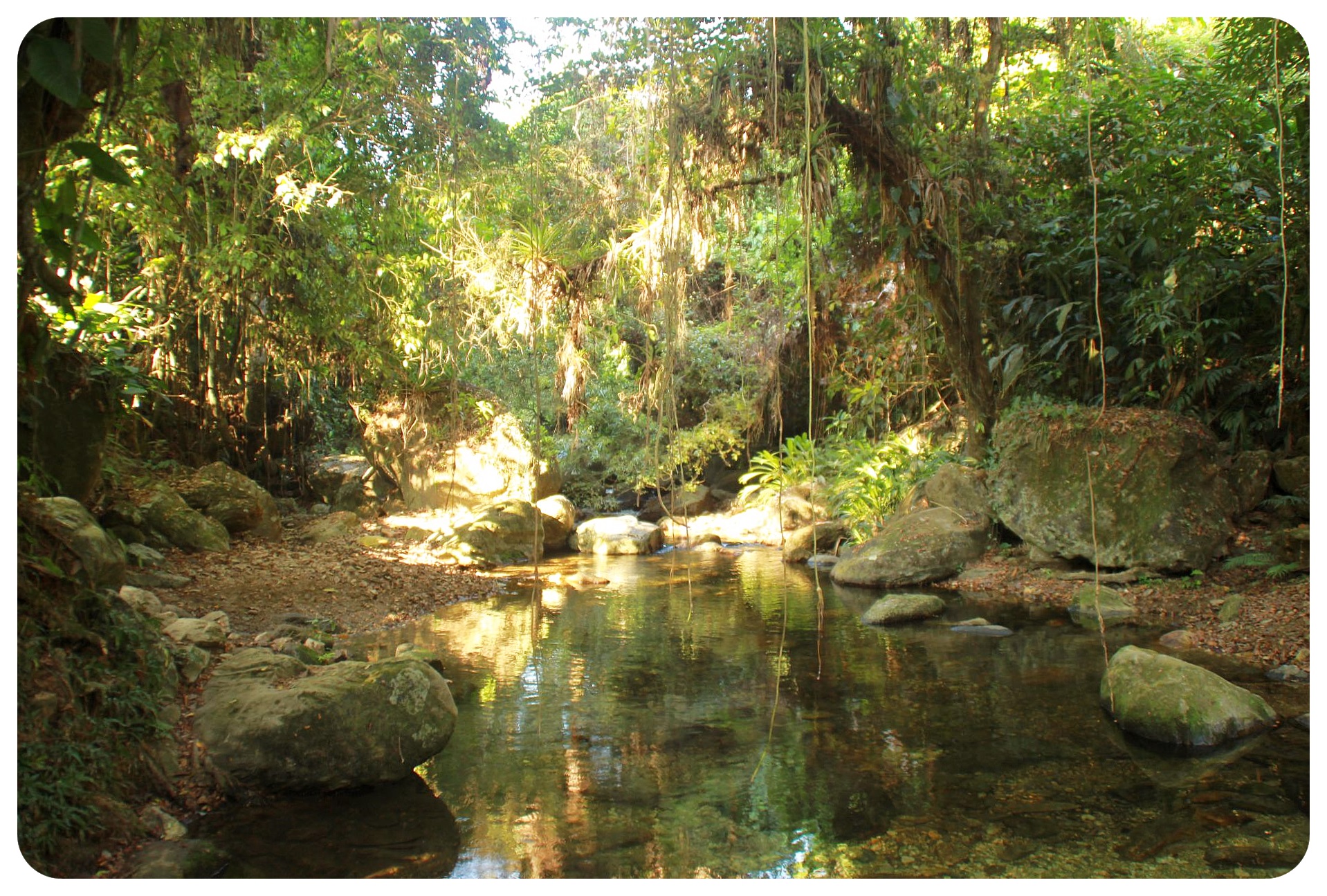 My body was thankful to get a decent amount of sleep before another 5am wake up call. Initially, I was supposed to walk for five days, but seeing that most people in my group made their way back to base camp on day 4, I decided to join them. This meant doing the hike that is broken up into two parts (Day 4 & 5) in only one day – a seven-hour hike.
My body was thankful to get a decent amount of sleep before another 5am wake up call. Initially, I was supposed to walk for five days, but seeing that most people in my group made their way back to base camp on day 4, I decided to join them. This meant doing the hike that is broken up into two parts (Day 4 & 5) in only one day – a seven-hour hike.
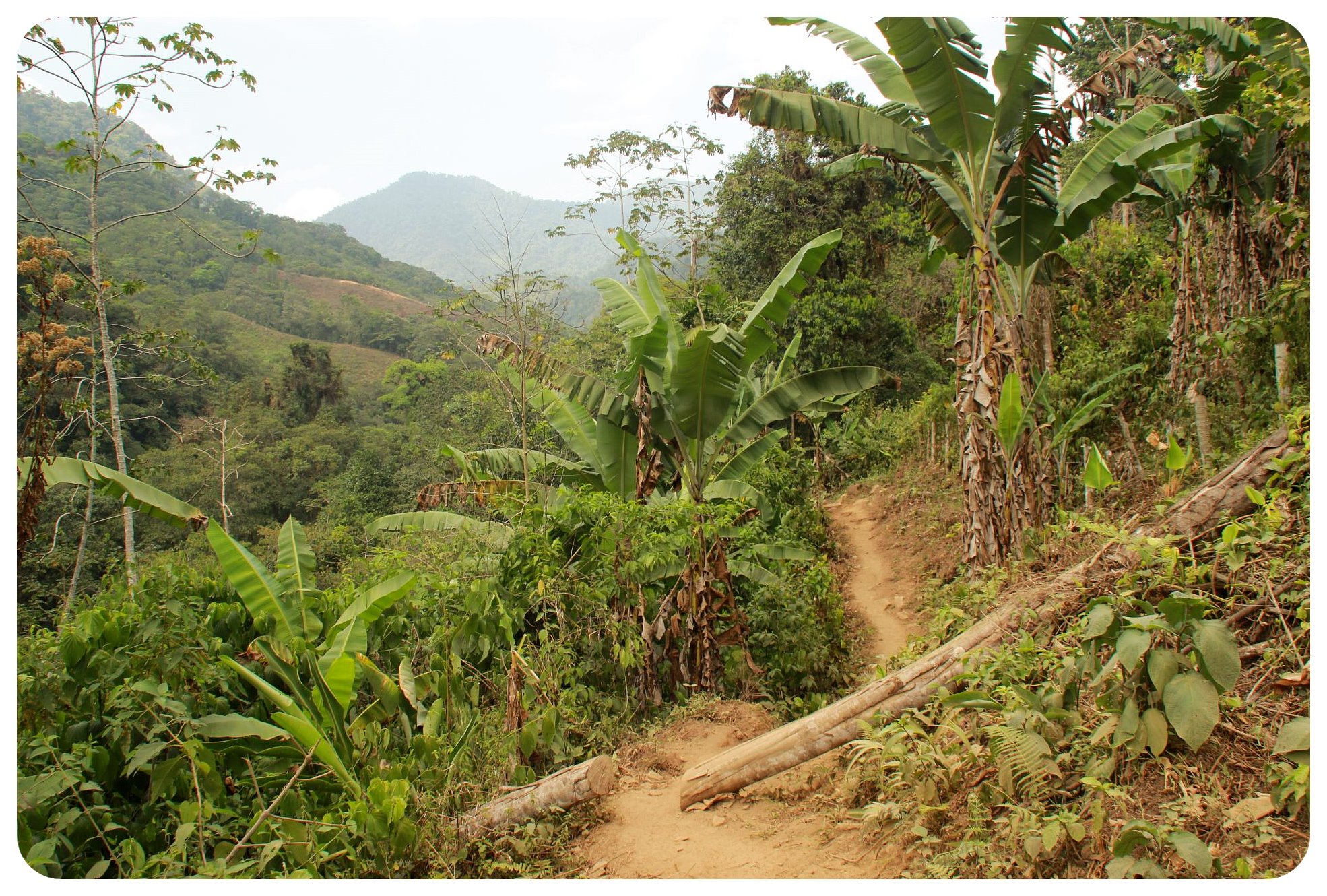 For some reason, I had blocked out that there was a big downhill part on the second day – a part that needed to be climbed now. It was an exhausting hike and I was glad when we reached camp 1 after three hours for a break with some watermelon and cake.
For some reason, I had blocked out that there was a big downhill part on the second day – a part that needed to be climbed now. It was an exhausting hike and I was glad when we reached camp 1 after three hours for a break with some watermelon and cake.
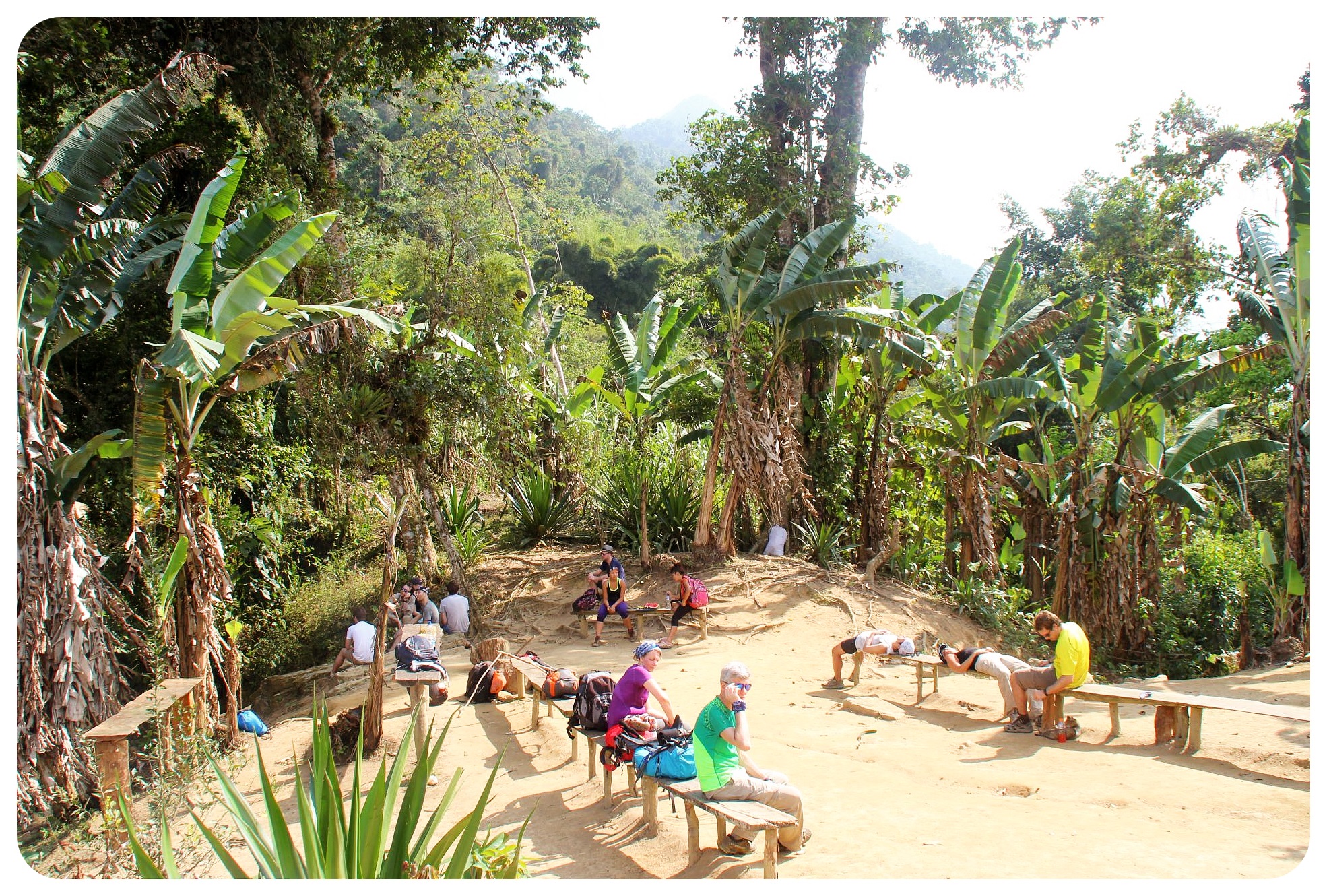 The rest of the hike was mostly downhill, and my feet were thankful for that, they started to hurt quite a bit and I couldn’t wait to trade my hiking boots for my flip flops again. This part of the Lost City trek was also extremely dusty – my clothes, backpack, legs and shoes were all covered in a thick layer of dust.
The rest of the hike was mostly downhill, and my feet were thankful for that, they started to hurt quite a bit and I couldn’t wait to trade my hiking boots for my flip flops again. This part of the Lost City trek was also extremely dusty – my clothes, backpack, legs and shoes were all covered in a thick layer of dust.
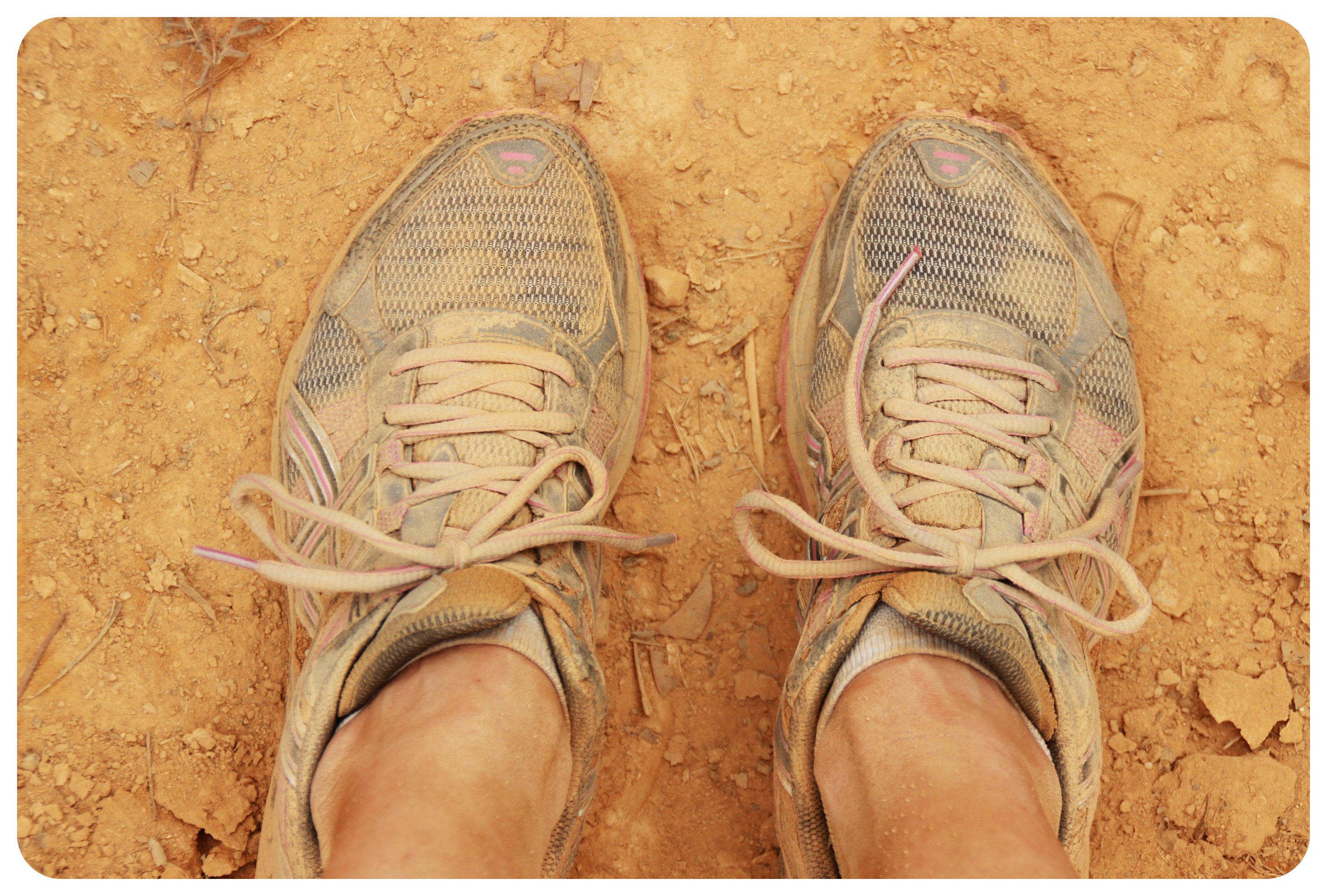 And then, finally, we arrived in El Mamey, the village where it had all began four days earlier. It had only taken us six hours to get there, but I was completely soaked in sweat and ready to rest my legs. A six-hour hike might not sound a lot, but this being the fourth day of walking in a row, and with the steep inclines and declines – it really exhausted me. I couldn’t wait to get back to Santa Marta to take a shower and have a good meal for dinner, after the fairly bland meals during the hike.
And then, finally, we arrived in El Mamey, the village where it had all began four days earlier. It had only taken us six hours to get there, but I was completely soaked in sweat and ready to rest my legs. A six-hour hike might not sound a lot, but this being the fourth day of walking in a row, and with the steep inclines and declines – it really exhausted me. I couldn’t wait to get back to Santa Marta to take a shower and have a good meal for dinner, after the fairly bland meals during the hike.
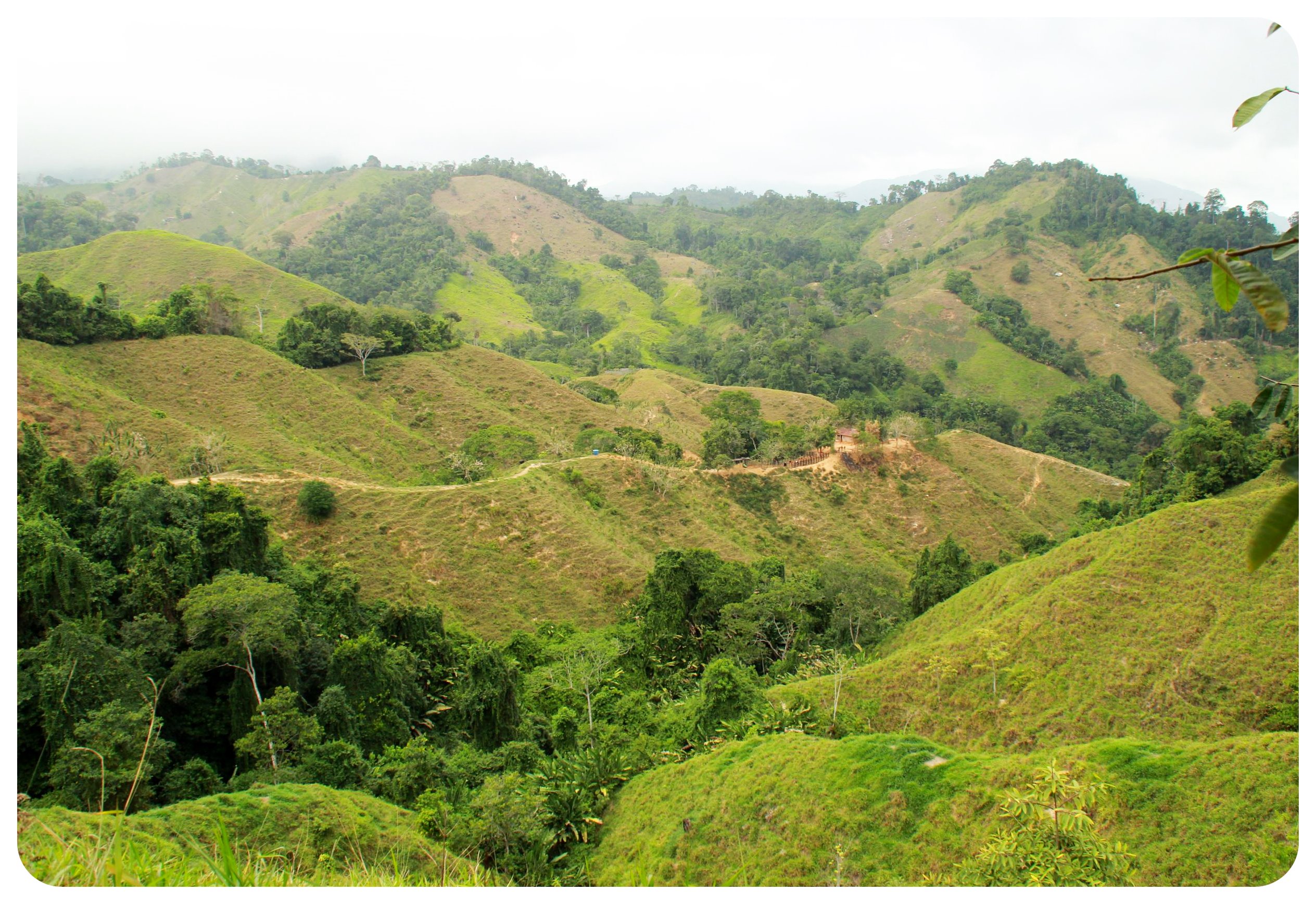 Was it worth the pain? Absolutely. I can’t believe that I was hesitant about doing the Lost City trek – if you like multi-day treks and want to see a pre-Columbian city that not a lot of people get to see, plus an amazing hike through the jungle, with sweeping mountain views and lots of swim breaks, make sure to add this trek to your Colombia itinerary.
Was it worth the pain? Absolutely. I can’t believe that I was hesitant about doing the Lost City trek – if you like multi-day treks and want to see a pre-Columbian city that not a lot of people get to see, plus an amazing hike through the jungle, with sweeping mountain views and lots of swim breaks, make sure to add this trek to your Colombia itinerary.
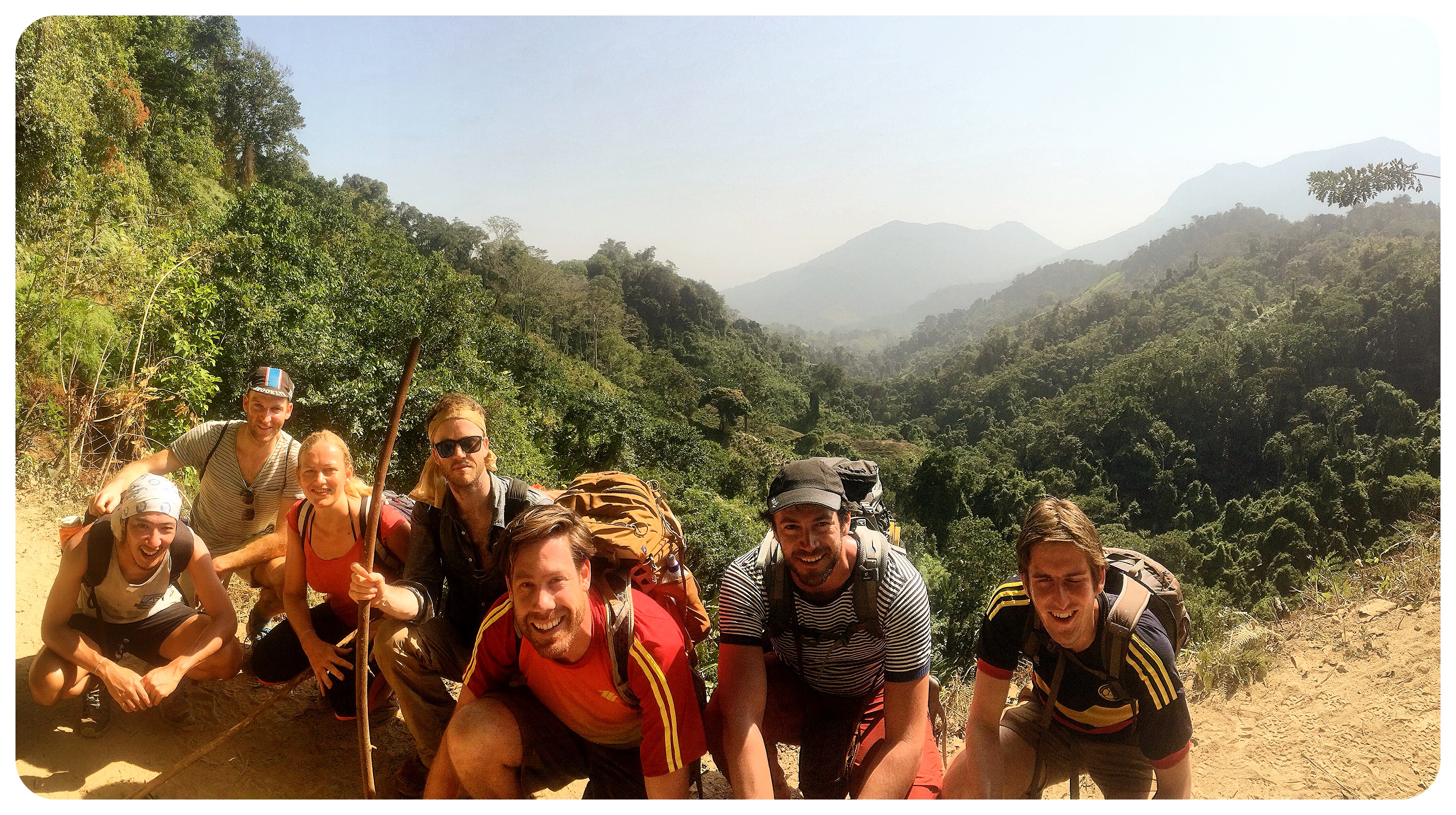 In hindsight, I couldn’t be happier about how my travel priorities had changed since the first time I was in Latin America all those years ago, because I am certain that I wouldn’t have done it in 2010 or 2011. The hike to the Lost City ended up being one of my favorite travel moments in Colombia!
In hindsight, I couldn’t be happier about how my travel priorities had changed since the first time I was in Latin America all those years ago, because I am certain that I wouldn’t have done it in 2010 or 2011. The hike to the Lost City ended up being one of my favorite travel moments in Colombia!
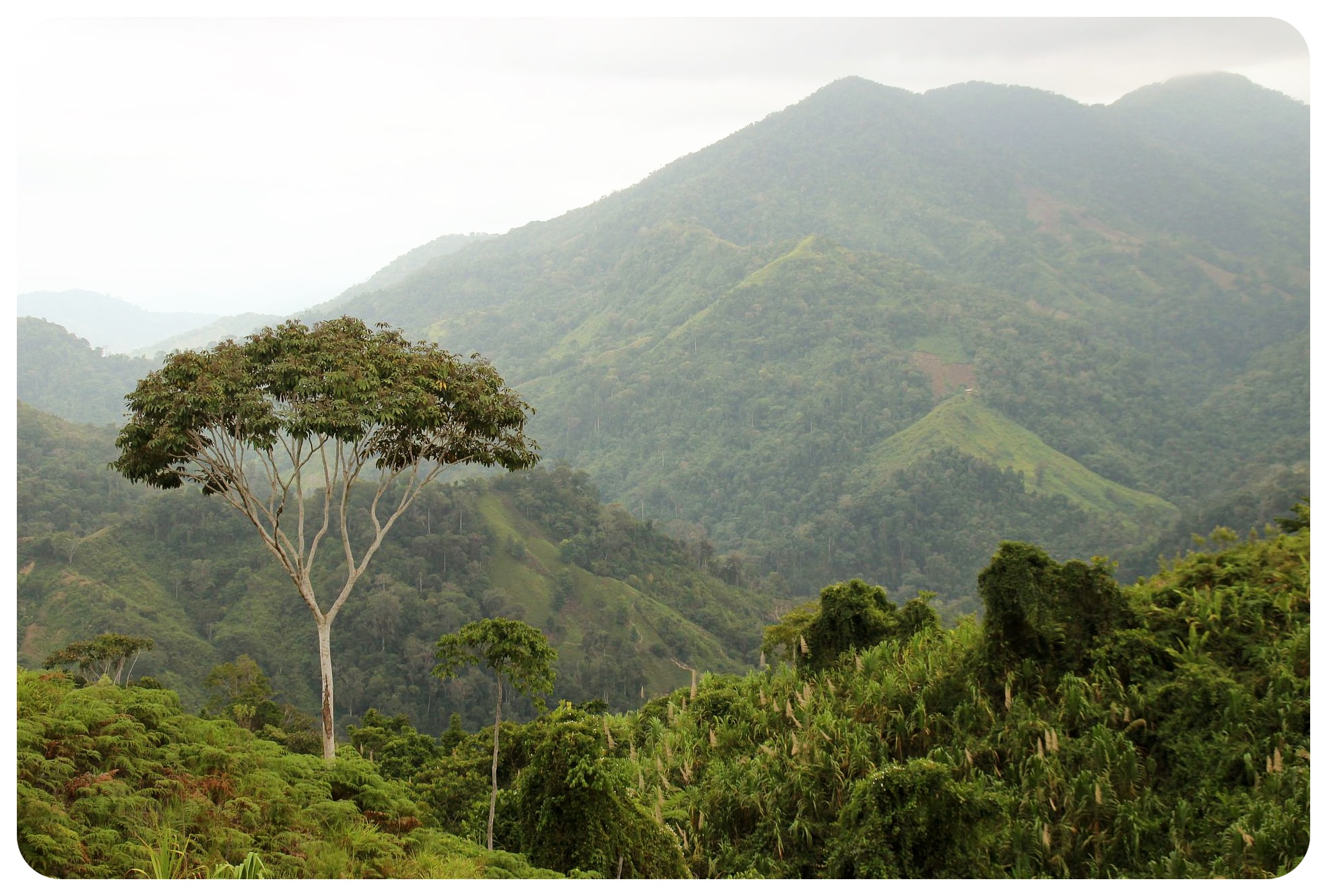
The Hike To Colombia’s Lost City: Practical Information
The Lost City Trek: Which tour company to go with
There are only four or five tour companies offering the Lost City trek, all charging COP700,000 (around US$240). Wiwa Tours is supposed to be the best one – and a girl I met who did the trek with them told me that not only did their guide tell them about the ruins when they got there, but also pointed out all kinds of fruits and plants along the way, explaining what they’re good for and trying them. This is the only tour company that uses indigenous guides, a definite bonus. BUT: Tours are in Spanish only.
If you want to be on the safe side, you can book the Trek to the Lost City online via Getyourguide – the upside is that you can read recent reviews about the tour company you choose; the downside is that you pay more because Getyourguide as the middleman takes a cut:
The other companies use English speaking guides. I went with Expoturs, and there are no complaints here. We had decent meals, and I always got a good vegetarian option (make sure to tell them about any dietary restrictions when you book your trek). We were provided with water and we got snacks along the way (fruit, cookies, lollipops).
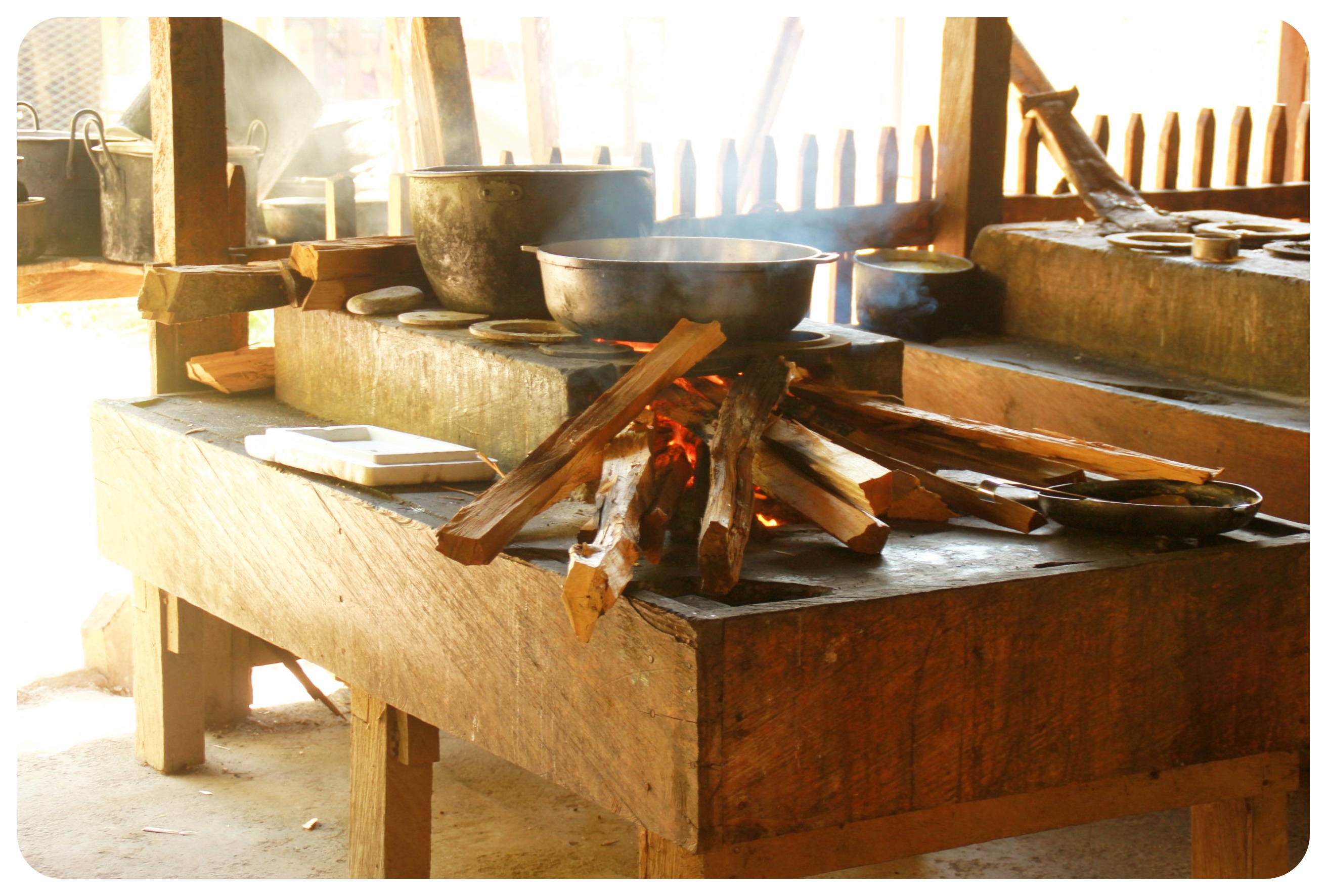
The Lost City Trek: The Camps
As for the camps – they’re all pretty much the same, no matter which tour company you go with. Plain beds, all lined up next to each other. If you don’t sleep well with other people, bring earplugs. Don’t expect hot showers or great bathrooms (some don’t have toilet paper) – everything is basic.
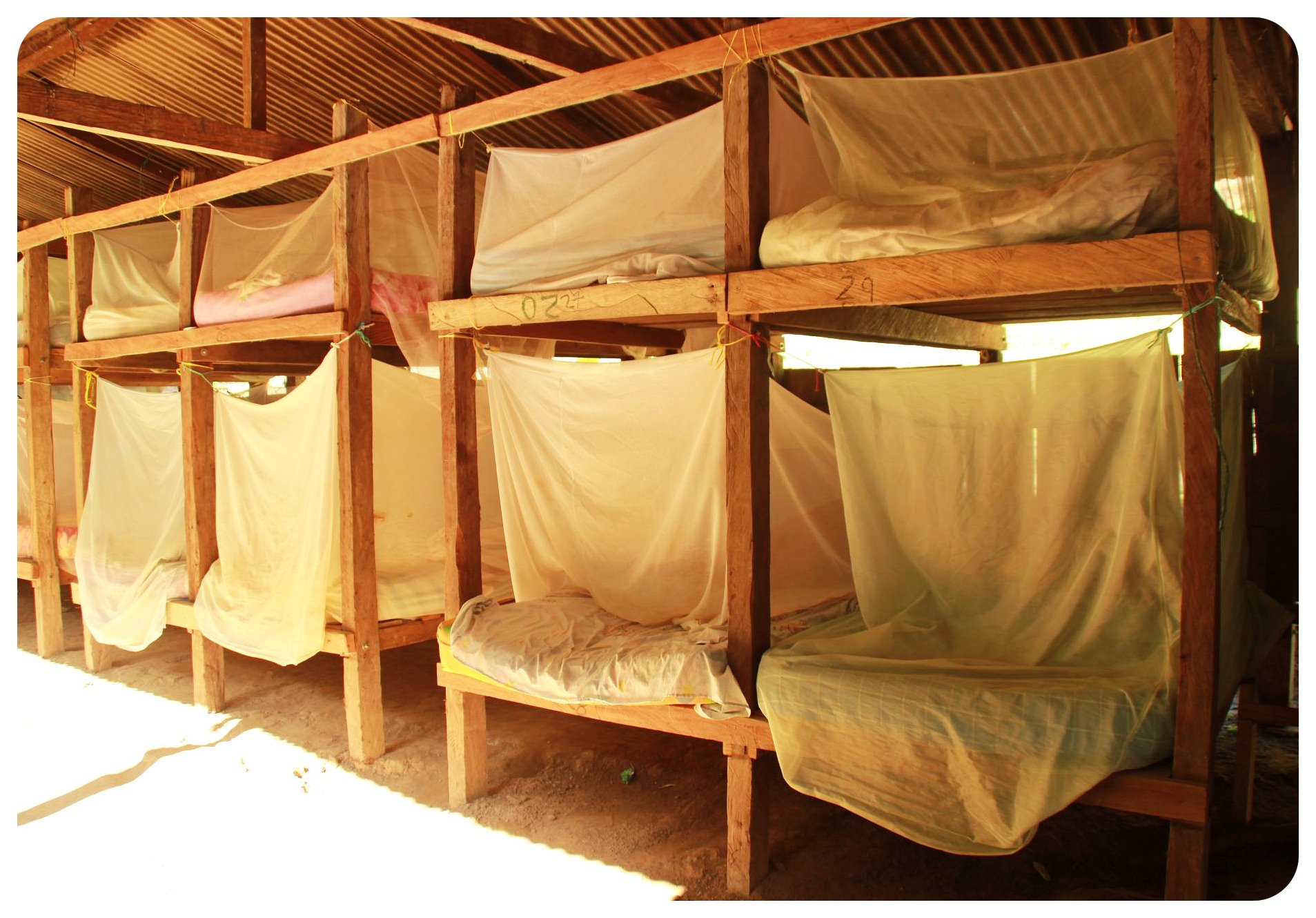
Packing essentials for the hike to Colombia’s Lost City
The most important thing I brought for the trek:
- the local mosquito repellent I bought (Nopikex, only about COP10,000/less than US$3, and it worked extremely well, and you can pick it up in a pharmacy in Santa Marta)
- sunblock
- wet wipes
- a headlamp (there is no light in the camps at night)
- my Kindle for some reading at night.
We wished we had a deck of cards but somehow nobody in our group had brought any.
You only need to bring a day pack for the hike, and you can store the rest of your stuff with the tour company until you return to Santa Marta (from where tours usually leave). Most hostels also offer to store your luggage, but some of them charge a fee, so check beforehand.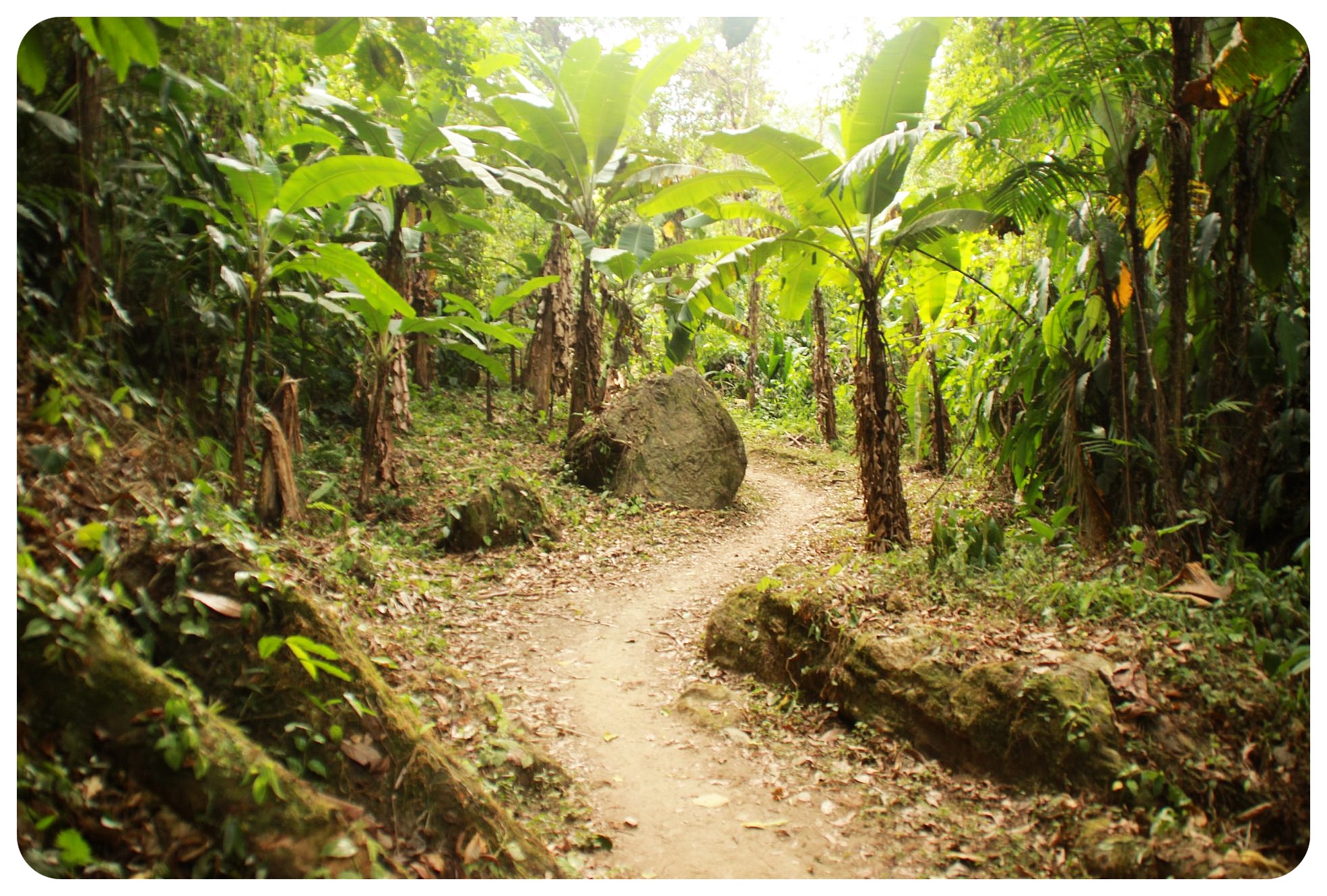
Other things to know about the Lost City Trek
- Depending on what time of year you are doing the hike, you might want to bring hiking sandals in addition to hiking boots, because the rivers fill up during the rainy season (April-May and September-November are the wettest months – expect downpours and bring a rain jacket). During the winter months (December – February) you don’t need any, but I was happy to have brought my flip flops to change into every night when we reached our camp for the night.
- Bring some cash because the camps all sell cold drinks, beer and sweets, and there are some kiosks along the way selling refreshments.
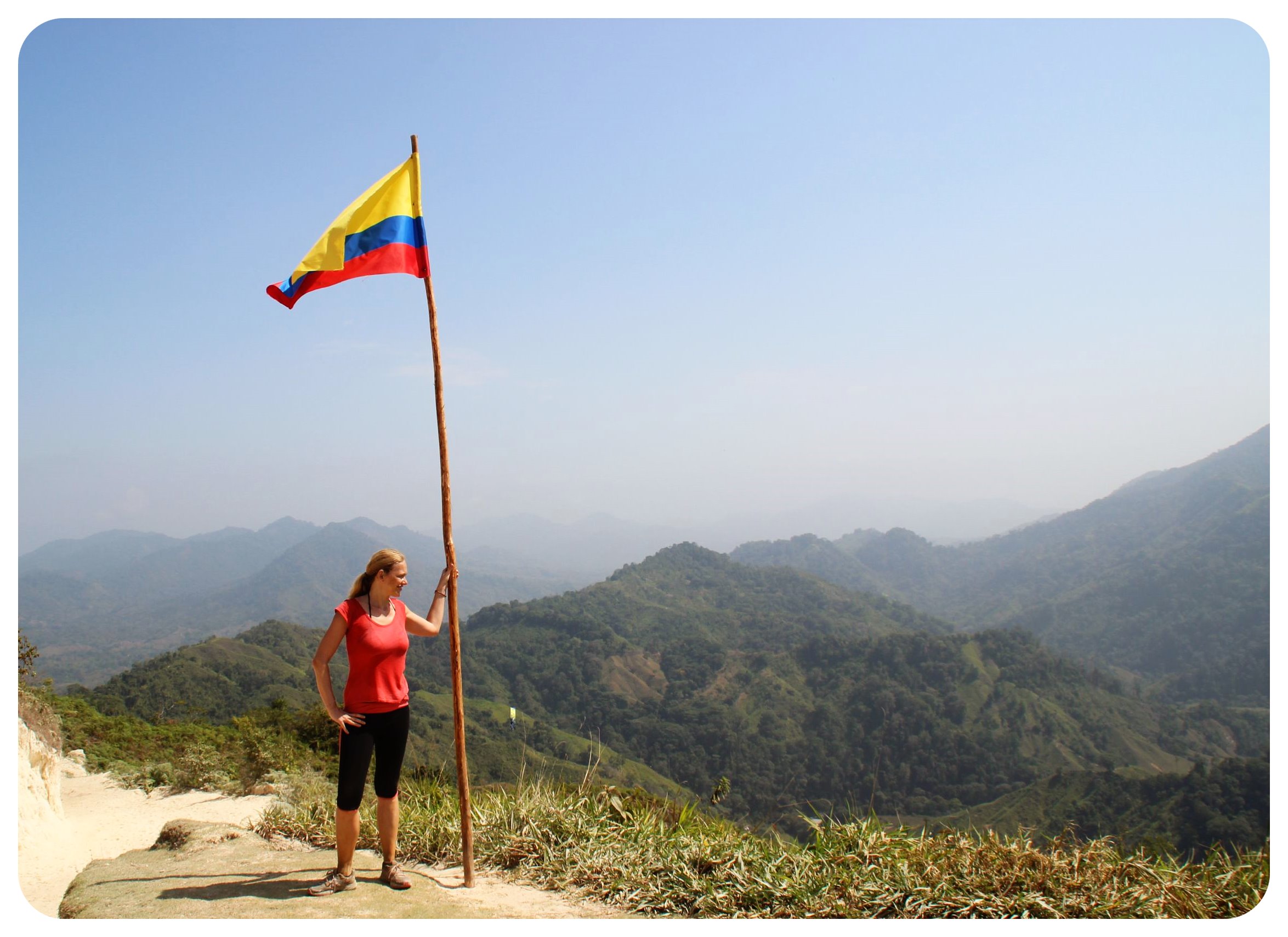 If you’re traveling in Colombia between December and February, spots fill up quickly. Make sure to reserve a spot early or be prepared to wait for a couple of days in Santa Marta until one opens up.
If you’re traveling in Colombia between December and February, spots fill up quickly. Make sure to reserve a spot early or be prepared to wait for a couple of days in Santa Marta until one opens up.- The Lost City is closed every year for two weeks in September for ceremonial rituals.

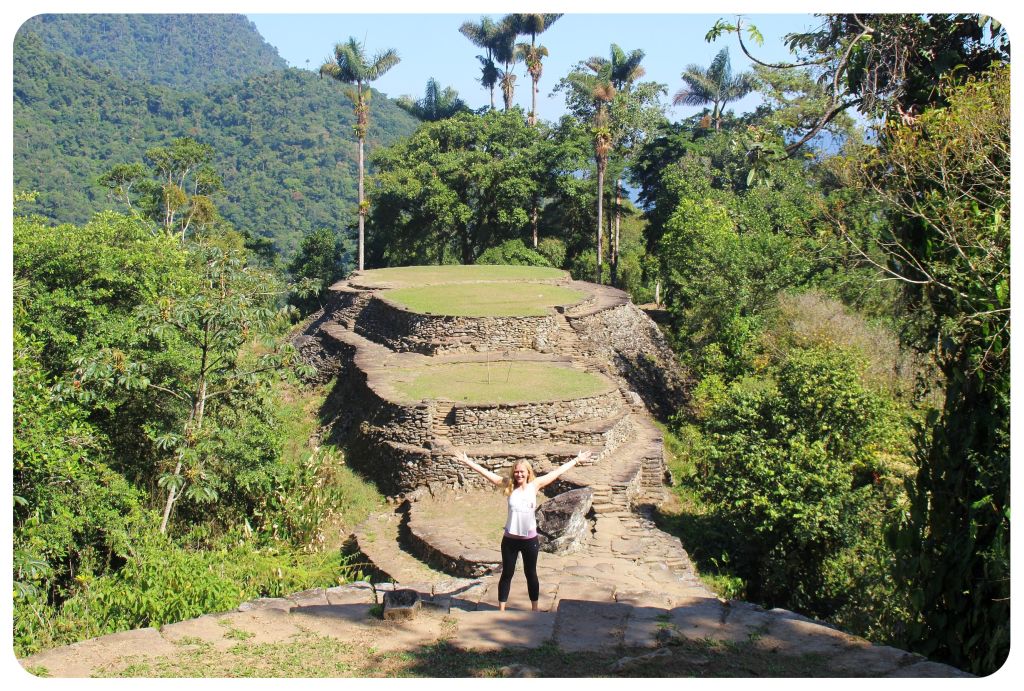

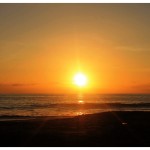
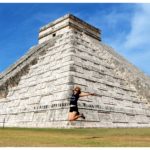
Ross
Tuesday 24th of May 2022
Thank you very much, great review!
I'd like to do the trek with Teyuna Tours.
Have you ever heard about them? Are they good?
Ross
Sunday 17th of March 2024
@Dani, thank you so much! It took me some time to finally travel to Colombia. I could arrange the Lost City trek with Teyuna Tours ( https://teyunatours.com/) and was worth it: incredibly supporting guides - who are actually the company owners -, great food and wonderful overall experience. The trail and campsites were significantly improved throughout the years, as I was told during the trek.
Thanks again!
Dani
Tuesday 7th of June 2022
Hi Ross, haven't heard of them, but if you end up doing the trek with Teyuna Tours feel free to report back how it was so that other people can check them out :)
The Travel Tester Favourite Blogs March 2017 | The Travel Tester
Tuesday 2nd of May 2017
[…] Channeling My Inner Lara Croft: The Jungle Trek To Colombia’s Lost City – GlobetrotterGirls […]